Paul van Yperen's Blog, page 225
August 16, 2019
Multi-picture postcards from the Soviet Union
In May this year, I was a few days in the beautiful city Riga in Latvia (lots of wonderful Art Nouveau and wooden buildings). In the street of our hotel, there was an 'antikvariāts', which we passed by every day. One day I went inside and asked the man behind the counter for vintage postcards, and yes, he even had some European film star postcards. In other 'antikvariāts', I was now getting steamed up, we found a lot of Russian postcards from the Soviet Union period. Of these, I prefer the multi-picture postcards in black and white from the 1950s. But the Cyrillic signs proved to be quite a puzzle. Happily, my sister Ellen once studied Russian and she helped me to decipher the Cyrillic signs and to translate the texts. So here are some of my finds from Riga. I added short bios of the actors, but if you want to know more about them, check our extended biographies of them at Flickr (just click twice at the postcard).

Russian postcard, series no. 33. Caption: My favourite artists. Film stars pictured are amongst others Viktor Avdyushko and Lyudmila Khityaeva in Vsyo nachinayetsya s dorogi/Everything Begins with Hitting the Road (Nikolay Dostal, Villen Azarov, 1960), Iya Arepina in Khmuryy Vangur/Gloomy Vangur (Anatoliy Dudorov, 1959), Tatyana Konyukhova and Evgeniy Samoylov in Zare navstrechu/Dawn to meet (Tatyana Lukashevich, 1960), Nadir Malishevsky and Evgeniya Kozyreva in Vesenniye grozy/Spring Thunderstorms (Nikolai Figurovsky, 1960), and Vasily Lanovoy.

Russian multi-view postcard by Izd. fabriki "Promhudožnik" gor. Kišinev, no. Ab08249. The card was issued in 10,000 copies. Retail price was 75 Kop. Pictures from Selskiy vrach/The Country Doctor (Sergey Gerasimov, 1952), Molodaya gvardiya/The Young Guard (Sergey Gerasimov, 1948) and Tri vstrechi (Aleksandr Ptushko, Vsevolod Pudovkin, Sergei Yutkevich, 1949).
Tamara Makarova (1907-1997) was a famous star of the Soviet cinema, who appeared in 31 films between 1927 and 1984. She was also a writer, and the wife and co-worker of director Sergey Gerasimov. Among her best known films are Kozintsev en Trauberg's Novyy Vavilon/The New Babylon (1929), Pudovkin's Dezertir/The Deserter (1933), and 16 films by Gerasimov.
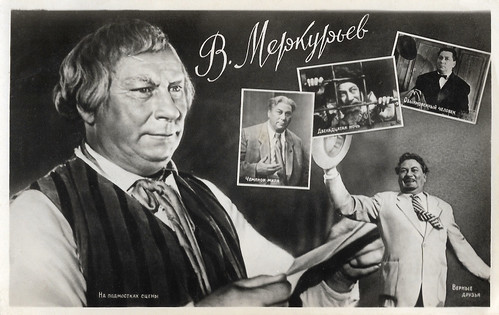
Soviet postcard by photo department Ed. 'Molot', Rostov-on-Don, no. 109, 1958. The card was issued in 75,000 copies. The price was 75 K. Pictures from Na podmostkakh stseny/Behind the Footlights (Konstantin Yudin, 1956), Chempion mira/World Champion (Vladimir Gonchukov, 1955), Dvenadtsataya noch/Twelfth Night (Yan Frid, 1955), Obyknovennyy chelovek/Ordinary Person (Aleksandr Stolbov, 1956) and Vernye druz'ya/True Friends (Mikhail Kalatozov, 1954).
Russian actor Vasiliy Merkurev (1904-1978) played more than 40 roles in Soviet films and he acted in over 100 stage plays of the Pushkin Drama Theatre (Aleksandrinski Theatre).He was also a stage director and drama teacher. His professional acting career spanned over 50 years.
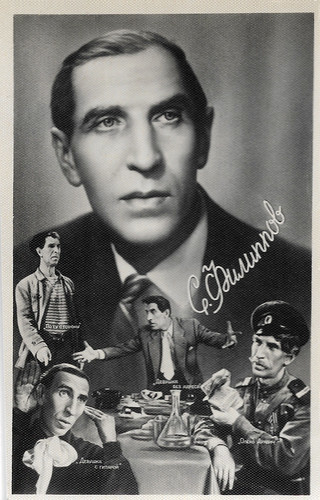
Soviet postcard by photo department Ed. 'Molot', Rostov-on-Don, no. 06453, 1959. The card was issued in 75,000 copies. The price was 75 K. Pictures from Po tu storonu/On the other side (Fyodor Filippov, 1958), Devushka s gitaroy/A Girl with Guitar (Aleksandr Faintsimmer, 1958), Devushka bez adresa/Girl Without an Address (Eldar Ryazanov, 1958), and Oleko Dundich/Aleksa Dundic (Leonid Lukov, 1958).
Sergey Filippov (1912-1990) was a comical Soviet film and theatre actor, best known for his parts in films like Priklyucheniya Korzinkinoi/Adventures of Korzinkina (1941), Notchnoi patrul/The Night Patrol (1957) and the adaptation of Ilf and Petrov's classic The Twelve Chairs (1971), which granted him the People's Artist of the RSFSR title in 1974. His life ended as a tragedy.
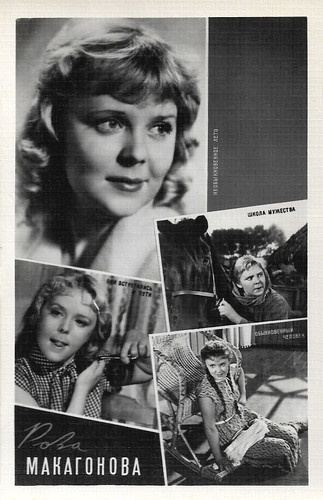
Soviet postcard by Izdaiie Bjuro propagandy sovetskogo kino-iskusstva, Lskusstva, 1961. Retail price: 8 K. Photos: publicity stills for Neobyknovennoye leto/An Unusual Summer (Vladimir Basov, 1957), Shkola muzhestva/Courage School (Vladimir Basov, Mstislav Korchagin, 1954), Oni vstretilis v puti/They Met on the Road (Tatyana Lukashevich, 1957), and Obyknovennyy chelovek/Ordinary person (Aleksandr Stolbov, 1956).
Roza Makagonova (1927-1995) was a Soviet actress. Makagonova was awarded as a Meritorious Artist of the USSR in 1976.
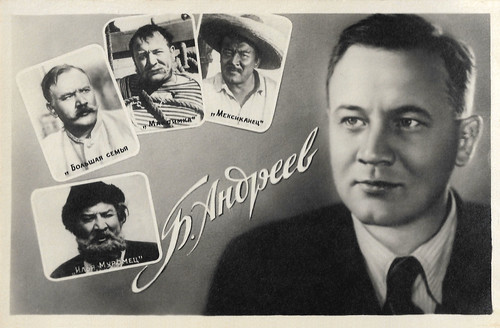
Soviet postcard by photo department Ed. 'Molot', Rostov-on-Don, no. 15, 1959. This postcard was printed in an edition of 100,000 cards. The price was 75 K. Among the pictures are from left to right publicity stills for Ilya Muromets/The Epic Hero and the Beast (Aleksandr Ptushko, 1956), Bolshaya semya/A Big Family (Iosif Kheifits, 1954), Maksimka/Maximka (Vladimir Braun, 1953), and Meksikanets/The Mexican (Vladimir Kaplunovskiy, 1956).
Boris Andreyev (1915-1982) was a mechanic turned actor. He became a leading star of the Soviet cinema who appeared in 51 films between 1939 and 1982. These included Skazanie o zemle sibirskoy (1948), Padenie Berlina (1950), and Bolshaya semya/A Big Family (1954).
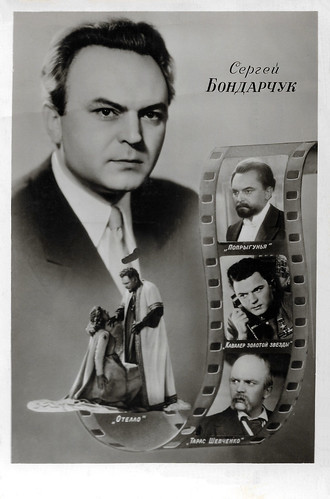
Soviet postcard, no. 4319, 1959. Retail price: 75 K. Photos: publicity stills for Otello/Othello (Sergei Yutkevich, 1956) with Irina Skobtseva, Poprygunya/The Cricket (Samson Samsonov, 1955), Kavalier zolotoy zvezdy/Cavalier of the Golden Star (Yuli Raizman, 1951), and Taras Shevchenko (Aleksandr Alov, Vladimir Naumov, Igor Savchenko, 1951).
Film director, co-producer, writer, and actor Sergey Bondarchuk (1920–1994) was one of the most important filmmakers of the Soviet Union and had a career that spanned over five decades. The theme of war ran through many of the films he directed. He won an Oscar for his spectacular epic Voyna i mir/War and Peace (1967), in which he also starred as Pierre Bezukhov.
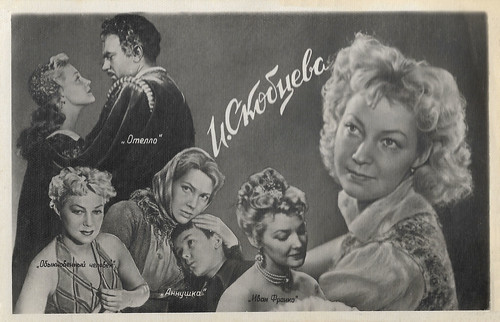
Soviet postcard by FK, Rostov on Don, Engels, no. 54. The card was issued in 100,000 copies. Pictures from Otello/Othello (Sergei Yutkevich, 1955), Obyknovennyy chelovek/The Ordinary Man (Aleksandr Stolbov, 1956), Annushka (Boris Barnet, 1959), and Ivan Franko (Timofei Levchuk, 1956).
Russian actress Irina Skobtseva (1927) was a famous star of the Soviet cinema. She was the second wife of Sergey Bondarchuk , and played Helen Kuragina in his epic film Voina i mir/War and Peace (1966), a powerful adaptation of the eponymous masterpiece by Leo Tolstoy.

Soviet postcard by photo department Ed. 'Molot', Rostov-on-Don, no. 109, 1958. The price was 75 K. Among the pictures are from left to right publicity stills for Devushka bez adresa/Girl Without an Address (Eldar Ryazanov, 1958), Zolushka/Cinderella (Nadezhda Kosheverova, Mikhail Shapiro, 1947), (unidentified film), and Nesterka/Nasty (Aleksandr Zarkhi, 1955).
Actor, screenwriter and director Erast Garin (1902-1980) was one of the film stars of the Soviet cinema. Together with Igor Ilyinsky and Sergey Martinson, he was one of the leading comic actors of Vsevolod Meyerhold's theatre company. Later, he was known for such films as Zhenitba (1936), Muzykalnaya istoriya/Musical Story (1940) and Zolushka/Cinderella (1947).
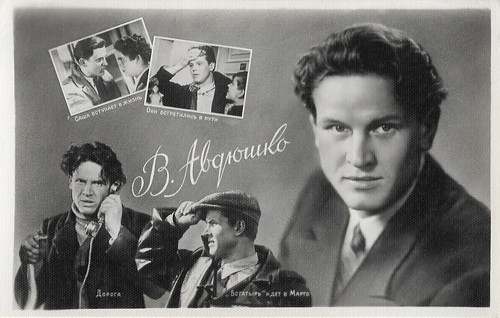
Soviet postcard, no. 115, 1958. Photos: a.o. publicity stills of Bogatyr idyot v Marto/The bogatyr goes to Marto (Yevgeni Bryunchugin, Sigizmund Navrotsky, 1954),Doroga/The Road (Aleksandr Stolper, 1955), Sasha vstupayet v zhizn/Sasha Enters Life (Mikhail Shvejtser, 1957) and Oni vstretilis v puti/They Met on the Road (Tatyana Lukashevich, 1957).
Viktor Avdyushko (1925-1975) was a Soviet film star, who appeared in over 40 feature films and TV productions. He was known for such films as Doroga/The Road (1955), Ottsy i deti (1959), and Januskopf/Janus (1972). He was named a People's Artist of the Russian Soviet Federative Socialist Republic.
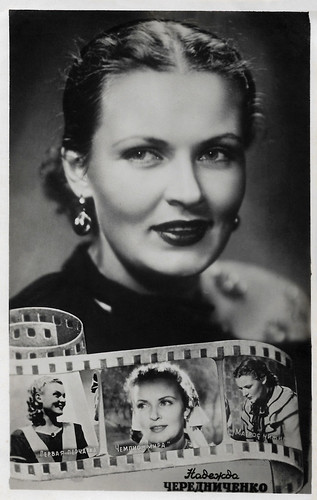
Russian multiview postcard by Izd. fabriki "Promhudožnik" gor. Kišinev, no. Abc8570, 1959. This postcard was printed in an edition of 40.000 cards. Retail price: 75 K. Pictures from Pervaya perchatka/The First Glove (Andrei Frolov, 1946),
Chempion mira/World Champion (Vladimir Gonchukov, 1954) and Matros Chizhik/My friend the sailor (Vladimir Braun, 1956).
Pretty Nadezhda Cherednichenko (1927) was a Soviet stage and film actress. Between 1954 and 1960 she played major parts in several films.
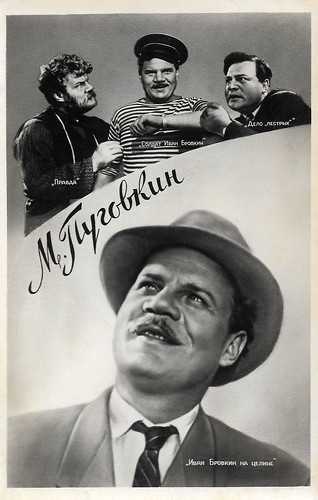
Soviet postcard by FK, Series no. 60, 7-III-60. This postcard was printed in an edition of 100.000 cards. Retail price: 75 K. Pictures from Pravda/Truth (Viktor Dobrovolsky, Isaak Shmaruk, 1957), Soldat Ivan Brovkin/Soldier Ivan Brovkin (Ivan Lukinsky, 1955), Delo Pyostrykh/The Variegateds Case (Nikolay Dostal, 1958) and Ivan Brovkin na tseline/Ivan Brovkin on the State Farm (Ivan Lukinsky, 1959).
Mikhail Pugovkin (1923-2008) was a Soviet and Russian comic actor, known for his roles in Svadba v Malinovke/Wedding in Malinovka (1967) and Ivan Vasilevich menyaet professiyu/Ivan Vasilievich: Back to the Future (1973). He was named a People's Artist of the USSR in 1988.

Soviet postcard by photo department Ed. 'Molot', Rostov-on-Don, no. 34, 1959. The card was issued in 75,000 copies. The price was 75 K. Pictures from Khozhdenie za tri morya/Journey Beyond Three Seas (Khwaja Ahmad Abbas, Vasili Pronin, 1957), Sorok pervyy/The Forty-First (Grigori Chukhrai, 1956), V tvoikh rukakh zhizn (Nikolai Rozantsev, 1959) and Kapitanskaya dochka/The Captain's Daughter (Vladimir Kaplunovskiy, 1958).
Prominent Russian actor Oleg Strizhenov (1929) was both People's Artist of the Soviet Union and a heartthrob, ‘a Russian Gérard Philipe ’. He played in more than 31 major films between 1951 and 2000.
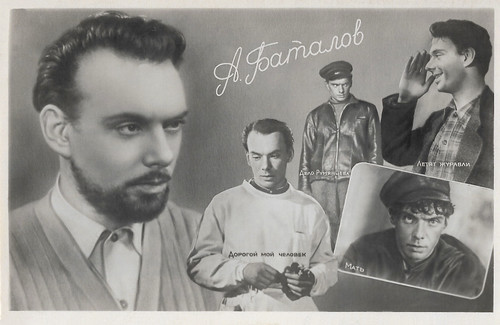
Russian postcard by FK, Rostov on Don, Engels, no. 54. The card was issued in 100,000 copies. Pictures from Dorogoy moy chelovek/My Beloved (Iosif Kheifits, 1958), Delo Rumyantseva/The Case of Sergei Rumyantsev (Iosif Kheifits, 1956), Mat/Mother (Mark Donskoy, 1956), and Letyat zhuravli/The Cranes Are Flying (Mikhail Kalatozov, 1957).
Russian actor and director Aleksey Batalov (1928-2017) played positive and noble characters in several classics of the Soviet cinema such as Bolshaya Semya/The Big Family (Iosif Kheifets, 1954), Letyat zhuravli/The Cranes Are Flying (Mikhail Kalatozov, 1957), Dama s sobachkoi/The Lady with the Dog (Iosif Kheifits, 1962), and Oscar winner Moskva slezam ne verit/Moscow Does Not Believe in Tears (Vladimir Menshov, 1979). He was named a People's Artist of the USSR in 1976 and a Hero of Socialist Labour in 1989.
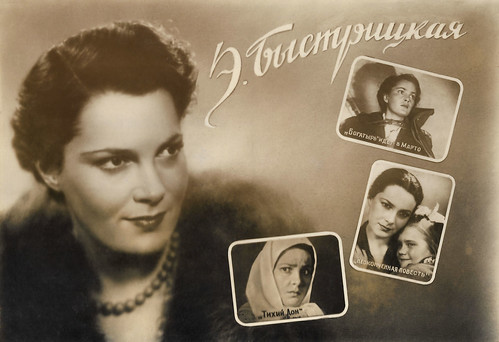
Russian multiview postcard, no. 115, 1958. Photos from above: Elina Bystritskaya in Bogatyr idyot v Marto/The bogatyr goes to Marto (Yevgeni Bryunchugin, Sigizmund Navrotsky, 1954), Neokonchennaya povest/Unfinished Story (Fridrikh Ermler, 1955) and Tikhiy Don/Quiet Flows the Don (Sergei Gerasimov, 1957).
Actress Elina Bystritskaya (1928-2019) was one of the most beautiful women of the Soviet cinema. She is best known for her role of Axinia in the epic film trilogy of Mikhail Sholokhov's novel Tikhiy Don/And Quiet Flows the Don (1957-1958) by Sergey Gerasimov.
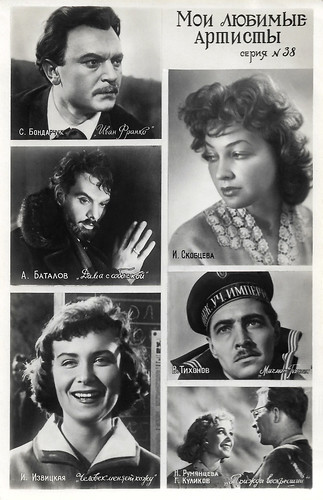
Russian postcard, series no. 38. Caption: My favourite artists. Film stars pictured are amongst others Sergey Bondarchuk, Aleksey Batalov, Izolda Izvitskaya, Irina Skobtseva and Vyacheslav Tikhonov.

Russian postcard, series no. 33. Caption: My favourite artists. Film stars pictured are amongst others Viktor Avdyushko and Lyudmila Khityaeva in Vsyo nachinayetsya s dorogi/Everything Begins with Hitting the Road (Nikolay Dostal, Villen Azarov, 1960), Iya Arepina in Khmuryy Vangur/Gloomy Vangur (Anatoliy Dudorov, 1959), Tatyana Konyukhova and Evgeniy Samoylov in Zare navstrechu/Dawn to meet (Tatyana Lukashevich, 1960), Nadir Malishevsky and Evgeniya Kozyreva in Vesenniye grozy/Spring Thunderstorms (Nikolai Figurovsky, 1960), and Vasily Lanovoy.

Russian multi-view postcard by Izd. fabriki "Promhudožnik" gor. Kišinev, no. Ab08249. The card was issued in 10,000 copies. Retail price was 75 Kop. Pictures from Selskiy vrach/The Country Doctor (Sergey Gerasimov, 1952), Molodaya gvardiya/The Young Guard (Sergey Gerasimov, 1948) and Tri vstrechi (Aleksandr Ptushko, Vsevolod Pudovkin, Sergei Yutkevich, 1949).
Tamara Makarova (1907-1997) was a famous star of the Soviet cinema, who appeared in 31 films between 1927 and 1984. She was also a writer, and the wife and co-worker of director Sergey Gerasimov. Among her best known films are Kozintsev en Trauberg's Novyy Vavilon/The New Babylon (1929), Pudovkin's Dezertir/The Deserter (1933), and 16 films by Gerasimov.

Soviet postcard by photo department Ed. 'Molot', Rostov-on-Don, no. 109, 1958. The card was issued in 75,000 copies. The price was 75 K. Pictures from Na podmostkakh stseny/Behind the Footlights (Konstantin Yudin, 1956), Chempion mira/World Champion (Vladimir Gonchukov, 1955), Dvenadtsataya noch/Twelfth Night (Yan Frid, 1955), Obyknovennyy chelovek/Ordinary Person (Aleksandr Stolbov, 1956) and Vernye druz'ya/True Friends (Mikhail Kalatozov, 1954).
Russian actor Vasiliy Merkurev (1904-1978) played more than 40 roles in Soviet films and he acted in over 100 stage plays of the Pushkin Drama Theatre (Aleksandrinski Theatre).He was also a stage director and drama teacher. His professional acting career spanned over 50 years.

Soviet postcard by photo department Ed. 'Molot', Rostov-on-Don, no. 06453, 1959. The card was issued in 75,000 copies. The price was 75 K. Pictures from Po tu storonu/On the other side (Fyodor Filippov, 1958), Devushka s gitaroy/A Girl with Guitar (Aleksandr Faintsimmer, 1958), Devushka bez adresa/Girl Without an Address (Eldar Ryazanov, 1958), and Oleko Dundich/Aleksa Dundic (Leonid Lukov, 1958).
Sergey Filippov (1912-1990) was a comical Soviet film and theatre actor, best known for his parts in films like Priklyucheniya Korzinkinoi/Adventures of Korzinkina (1941), Notchnoi patrul/The Night Patrol (1957) and the adaptation of Ilf and Petrov's classic The Twelve Chairs (1971), which granted him the People's Artist of the RSFSR title in 1974. His life ended as a tragedy.

Soviet postcard by Izdaiie Bjuro propagandy sovetskogo kino-iskusstva, Lskusstva, 1961. Retail price: 8 K. Photos: publicity stills for Neobyknovennoye leto/An Unusual Summer (Vladimir Basov, 1957), Shkola muzhestva/Courage School (Vladimir Basov, Mstislav Korchagin, 1954), Oni vstretilis v puti/They Met on the Road (Tatyana Lukashevich, 1957), and Obyknovennyy chelovek/Ordinary person (Aleksandr Stolbov, 1956).
Roza Makagonova (1927-1995) was a Soviet actress. Makagonova was awarded as a Meritorious Artist of the USSR in 1976.

Soviet postcard by photo department Ed. 'Molot', Rostov-on-Don, no. 15, 1959. This postcard was printed in an edition of 100,000 cards. The price was 75 K. Among the pictures are from left to right publicity stills for Ilya Muromets/The Epic Hero and the Beast (Aleksandr Ptushko, 1956), Bolshaya semya/A Big Family (Iosif Kheifits, 1954), Maksimka/Maximka (Vladimir Braun, 1953), and Meksikanets/The Mexican (Vladimir Kaplunovskiy, 1956).
Boris Andreyev (1915-1982) was a mechanic turned actor. He became a leading star of the Soviet cinema who appeared in 51 films between 1939 and 1982. These included Skazanie o zemle sibirskoy (1948), Padenie Berlina (1950), and Bolshaya semya/A Big Family (1954).

Soviet postcard, no. 4319, 1959. Retail price: 75 K. Photos: publicity stills for Otello/Othello (Sergei Yutkevich, 1956) with Irina Skobtseva, Poprygunya/The Cricket (Samson Samsonov, 1955), Kavalier zolotoy zvezdy/Cavalier of the Golden Star (Yuli Raizman, 1951), and Taras Shevchenko (Aleksandr Alov, Vladimir Naumov, Igor Savchenko, 1951).
Film director, co-producer, writer, and actor Sergey Bondarchuk (1920–1994) was one of the most important filmmakers of the Soviet Union and had a career that spanned over five decades. The theme of war ran through many of the films he directed. He won an Oscar for his spectacular epic Voyna i mir/War and Peace (1967), in which he also starred as Pierre Bezukhov.

Soviet postcard by FK, Rostov on Don, Engels, no. 54. The card was issued in 100,000 copies. Pictures from Otello/Othello (Sergei Yutkevich, 1955), Obyknovennyy chelovek/The Ordinary Man (Aleksandr Stolbov, 1956), Annushka (Boris Barnet, 1959), and Ivan Franko (Timofei Levchuk, 1956).
Russian actress Irina Skobtseva (1927) was a famous star of the Soviet cinema. She was the second wife of Sergey Bondarchuk , and played Helen Kuragina in his epic film Voina i mir/War and Peace (1966), a powerful adaptation of the eponymous masterpiece by Leo Tolstoy.

Soviet postcard by photo department Ed. 'Molot', Rostov-on-Don, no. 109, 1958. The price was 75 K. Among the pictures are from left to right publicity stills for Devushka bez adresa/Girl Without an Address (Eldar Ryazanov, 1958), Zolushka/Cinderella (Nadezhda Kosheverova, Mikhail Shapiro, 1947), (unidentified film), and Nesterka/Nasty (Aleksandr Zarkhi, 1955).
Actor, screenwriter and director Erast Garin (1902-1980) was one of the film stars of the Soviet cinema. Together with Igor Ilyinsky and Sergey Martinson, he was one of the leading comic actors of Vsevolod Meyerhold's theatre company. Later, he was known for such films as Zhenitba (1936), Muzykalnaya istoriya/Musical Story (1940) and Zolushka/Cinderella (1947).

Soviet postcard, no. 115, 1958. Photos: a.o. publicity stills of Bogatyr idyot v Marto/The bogatyr goes to Marto (Yevgeni Bryunchugin, Sigizmund Navrotsky, 1954),Doroga/The Road (Aleksandr Stolper, 1955), Sasha vstupayet v zhizn/Sasha Enters Life (Mikhail Shvejtser, 1957) and Oni vstretilis v puti/They Met on the Road (Tatyana Lukashevich, 1957).
Viktor Avdyushko (1925-1975) was a Soviet film star, who appeared in over 40 feature films and TV productions. He was known for such films as Doroga/The Road (1955), Ottsy i deti (1959), and Januskopf/Janus (1972). He was named a People's Artist of the Russian Soviet Federative Socialist Republic.

Russian multiview postcard by Izd. fabriki "Promhudožnik" gor. Kišinev, no. Abc8570, 1959. This postcard was printed in an edition of 40.000 cards. Retail price: 75 K. Pictures from Pervaya perchatka/The First Glove (Andrei Frolov, 1946),
Chempion mira/World Champion (Vladimir Gonchukov, 1954) and Matros Chizhik/My friend the sailor (Vladimir Braun, 1956).
Pretty Nadezhda Cherednichenko (1927) was a Soviet stage and film actress. Between 1954 and 1960 she played major parts in several films.

Soviet postcard by FK, Series no. 60, 7-III-60. This postcard was printed in an edition of 100.000 cards. Retail price: 75 K. Pictures from Pravda/Truth (Viktor Dobrovolsky, Isaak Shmaruk, 1957), Soldat Ivan Brovkin/Soldier Ivan Brovkin (Ivan Lukinsky, 1955), Delo Pyostrykh/The Variegateds Case (Nikolay Dostal, 1958) and Ivan Brovkin na tseline/Ivan Brovkin on the State Farm (Ivan Lukinsky, 1959).
Mikhail Pugovkin (1923-2008) was a Soviet and Russian comic actor, known for his roles in Svadba v Malinovke/Wedding in Malinovka (1967) and Ivan Vasilevich menyaet professiyu/Ivan Vasilievich: Back to the Future (1973). He was named a People's Artist of the USSR in 1988.

Soviet postcard by photo department Ed. 'Molot', Rostov-on-Don, no. 34, 1959. The card was issued in 75,000 copies. The price was 75 K. Pictures from Khozhdenie za tri morya/Journey Beyond Three Seas (Khwaja Ahmad Abbas, Vasili Pronin, 1957), Sorok pervyy/The Forty-First (Grigori Chukhrai, 1956), V tvoikh rukakh zhizn (Nikolai Rozantsev, 1959) and Kapitanskaya dochka/The Captain's Daughter (Vladimir Kaplunovskiy, 1958).
Prominent Russian actor Oleg Strizhenov (1929) was both People's Artist of the Soviet Union and a heartthrob, ‘a Russian Gérard Philipe ’. He played in more than 31 major films between 1951 and 2000.

Russian postcard by FK, Rostov on Don, Engels, no. 54. The card was issued in 100,000 copies. Pictures from Dorogoy moy chelovek/My Beloved (Iosif Kheifits, 1958), Delo Rumyantseva/The Case of Sergei Rumyantsev (Iosif Kheifits, 1956), Mat/Mother (Mark Donskoy, 1956), and Letyat zhuravli/The Cranes Are Flying (Mikhail Kalatozov, 1957).
Russian actor and director Aleksey Batalov (1928-2017) played positive and noble characters in several classics of the Soviet cinema such as Bolshaya Semya/The Big Family (Iosif Kheifets, 1954), Letyat zhuravli/The Cranes Are Flying (Mikhail Kalatozov, 1957), Dama s sobachkoi/The Lady with the Dog (Iosif Kheifits, 1962), and Oscar winner Moskva slezam ne verit/Moscow Does Not Believe in Tears (Vladimir Menshov, 1979). He was named a People's Artist of the USSR in 1976 and a Hero of Socialist Labour in 1989.

Russian multiview postcard, no. 115, 1958. Photos from above: Elina Bystritskaya in Bogatyr idyot v Marto/The bogatyr goes to Marto (Yevgeni Bryunchugin, Sigizmund Navrotsky, 1954), Neokonchennaya povest/Unfinished Story (Fridrikh Ermler, 1955) and Tikhiy Don/Quiet Flows the Don (Sergei Gerasimov, 1957).
Actress Elina Bystritskaya (1928-2019) was one of the most beautiful women of the Soviet cinema. She is best known for her role of Axinia in the epic film trilogy of Mikhail Sholokhov's novel Tikhiy Don/And Quiet Flows the Don (1957-1958) by Sergey Gerasimov.

Russian postcard, series no. 38. Caption: My favourite artists. Film stars pictured are amongst others Sergey Bondarchuk, Aleksey Batalov, Izolda Izvitskaya, Irina Skobtseva and Vyacheslav Tikhonov.
Published on August 16, 2019 22:00
August 15, 2019
Betty Bronson
Sprightly and merry Betty Bronson (1906-1971) rocketed from obscurity when she was personally selected by J.M. Barrie to star in Peter Pan (1924). It remains her most famous part, even if she also had a small but significant part as The Holy Virgin Mary in Ben-Hur (Fred Niblo, 1925) and starred in the delicious but less popular A Kiss for Cinderella (1925), again based on Barrie. In the early sound era, Bronson played in the Al Jolson film The Singing Fool (1929) and its sequel Sonny Boy (1929).
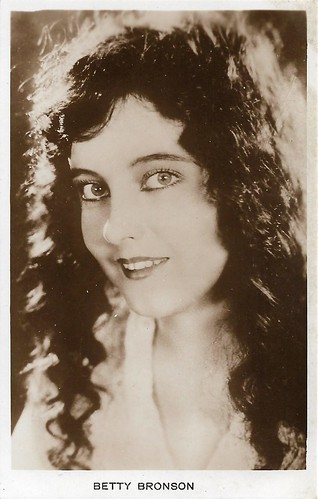
British Real Photograph postcard.
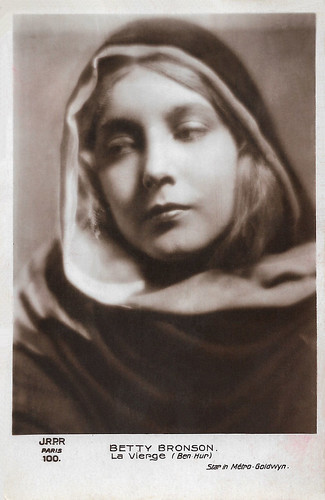
French postcard by JRPR, Paris, no. 100. Photo: Metro-Goldwyn. Betty Bronson as The Holy Virgin in Ben-Hur (Fred Niblo, 1925).
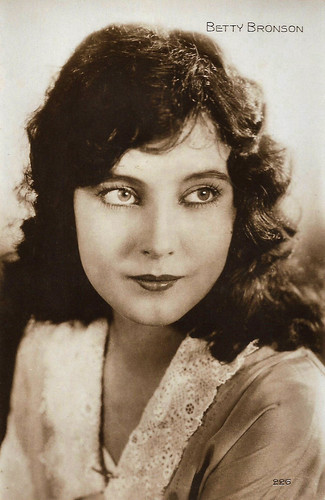
French postcard by Editions Cinémagazine, no. 226.
Betty Bronson Mania
Elizabeth Ada 'Betty' Bronson was born in Trenton, New Jersey, in 1906, to Frank and Nellie Smith Bronson. She moved to East Orange, New Jersey and attended East Orange High School until she convinced her parents to let her move to California to aid her career in films. Subsequently, the entire family moved to California.
Bronson began her film career at the age of 16 with a bit part in the silent romantic drama Anna Ascends (Victor Fleming, 1922). Alice Brady reprises in the film her starring role from the 1920 Broadway play of the same name about a working class Syrian American waitress who through hard work 'ascends' the social and economic ladder and becomes successful in the United States.
It was followed by more small roles in the silent romantic drama Java Head (George Melford, 1923) starring Leatrice Joy and Jacqueline Logan , the drama His Children's Children (Sam Wood, 1923) starring winsome Bebe Daniels , and The Eternal City (George Fitzmaurice, 1923), starring Barbara La Marr.
At 17, Betty was interviewed by J. M. Barrie, author of 'Peter Pan'. Although the role had been sought by such established actresses as Gloria Swanson and Mary Pickford , Barrie personally chose Bronson to play the lead in the film adaptation of his work, Peter Pan (Herbert Brenon, 1924). She appeared alongside actresses Mary Brian (Wendy Darling) and Esther Ralston (Mrs. Darling), both of whom remained lifelong friends. Ernest Torrence played Captain Hook, Virginia Browne Faire was Tinker Bell, and Chinese-American actress Anna May Wong played the Indian princess Tiger Lily. The film was celebrated at the time for its innovative use of special effects, mainly to show Tinker Bell.
Peter Pan (Herbert Brenon, 1924) closely follows the plot of the original play, and even goes so far as to incorporate much of its original stage dialogue in the intertitles. Added scenes include Nana the dog pouring out Michael's medicine and giving him a bath, and Nana bursting into the home at which a party is being given, to warn Mr. and Mrs. Darling that Peter Pan and the Darling children are flying around the nursery. Like the original play and several other versions, and unlike the 1953 Disney film, the 1924 version makes it clear that Wendy harbours a romantic attachment to Peter, but Peter only thinks of her as his mother.
Camille Scaysbrook at IMDb : "Betty's beautifully expressive performance and unsophisticated looks earned her instant success. For the year following Peter Pan's release, Bronson-mania easily equaled the sort of hysteria previously reserved only for Pickford."
Bronson starred in such films as the comedy Are Parents People? (Malcolm St. Clair 1925) with Florence Vidor and Adolphe Menjou , and Not So Long Ago (Sidney Olcott, 1925) with Ricardo Cortez. She had a small but significant part as The Holy Virgin Mary in the silent film adaptation of Ben-Hur (Fred Niblo, 1925), with Ramon Novarro in the title role.
In 1925, she starred in another J. M. Barrie story, A Kiss for Cinderella (Herbert Brenon, 1925) with Esther Ralston and Tom Moore, an artfully made film that failed at the box office. In only one year the public taste had changed so much as to render the sentimental entertainment of yesteryear obsolete.
Audiences were suddenly more interested in the more adult charms of flappers such as Clara Bow and Colleen Moore . Betty, too, was re-launched as a flapper, sophisticate and occasional period dame in such films as the comedy The Cat's Pajamas (William A. Wellman, 1926) with Ricardo Cortez and Arlette Marchal , and the successful escapist-romance Paradise (Irvin Willat, 1926) with Milton Sills.
Her career was moderately successful but her superstardom had subsided.
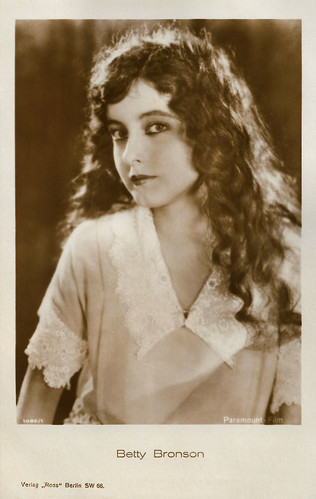
German postcard by Ross Verlag, no. 1095/1, 1927-1928. Photo: Paramount-Film.
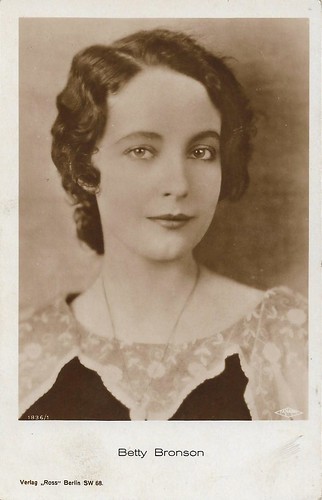
German postcard by Ross Verlag, no. 1836/1, 1927-1928. Photo: Fanamet.
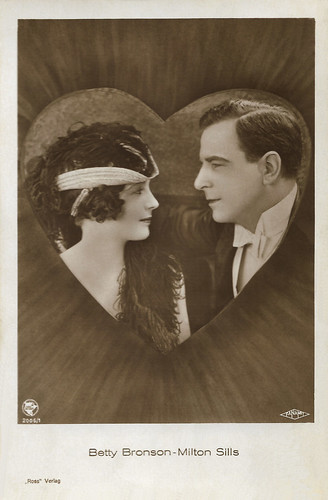
German postcard by Ross Verlag, no. 2006/1, 1927-1928. Photo: First National / Fanamet. Betty Bronson and Milton Sills acted together in Paradise (Irvin Willat, 1926).
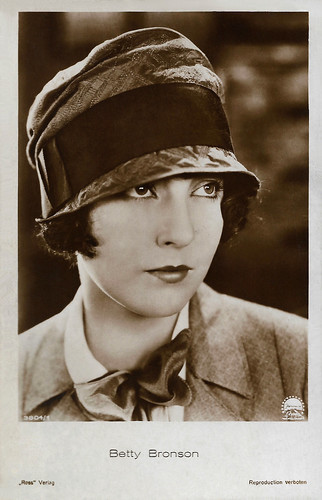
German postcard by Ross Verlag, no. 3804/1, 1928-1929. Photo: Paramount Pictures.
An excellent voice
Betty Bronson made a successful transition into sound films. She sparkled and demonstrated an excellent voice in The Singing Fool (Lloyd Bacon, 1928), co-starring Al Jolson. The part talking film was a follow-up to Jolson's previous film, The Jazz Singer (Alan Crosland, 1927). The Singing Fool is credited with helping to cement the popularity of American films of both sound and the musical genre. Bronson also appeared in the sequel, Sonny Boy (Archie Mayo, 1929), with Davey Lee and Edward Everett Horton.
Bronson was the leading lady opposite vaudeville star Jack Benny in the romantic drama The Medicine Man (Scott Pembroke, 1930). She played the daughter of a shopkeeper who falls in with the leader of a travelling medicine show.
Bronson continued acting until 1933 when she married Ludwig Lauerhass, a well‐to‐do North Carolinian, with whom she had one child, Ludwig Lauerhass, Jr, who later became a lecturer in history emeritus at the University of California, Los Angeles. She did not appear in films again until Yodelin' Kid from Pine Ridge (Joseph Kane, 1937) starring singing cowboy Gene Autry.
In the 1960s, she appeared in episodic television and feature films, such as in Frank Capra's final film, Pocketful of Miracles (1961), starring Bette Davis and Glenn Ford, and Samuel Fuller's Neo Noir The Naked Kiss (1964). Her last screen appearance was an uncredited part in the television biopic Evel Knievel (Marvin J. Chomsky, 1971), starring George Hamilton as motorcycle daredevil Evel Knievel.
In 1971, Betty Bronson died after a protracted illness in Pasadena, California, and was interred at Forest Lawn Memorial Park in Glendale, California. She was 64 and survived by her son, a brother, a sister, and two grandchildren.
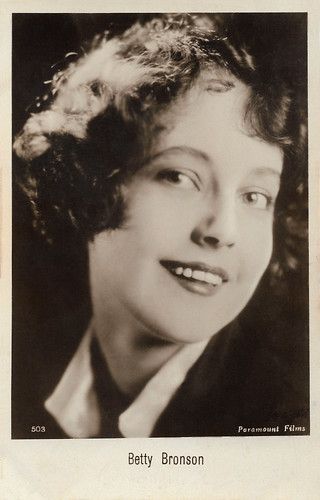
Italian postcard by G.B. Falci Editore, Milano, no. 503. Photo: Paramount Films.
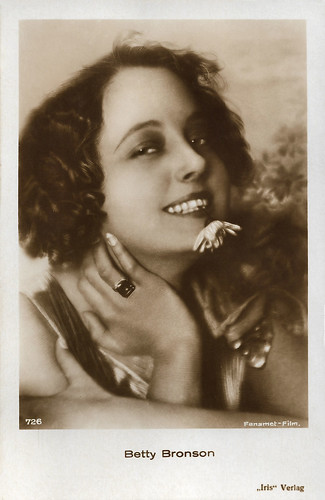
Austrian postcard by Iris Verlag, no. 726. Photo: Fanamet-Film.
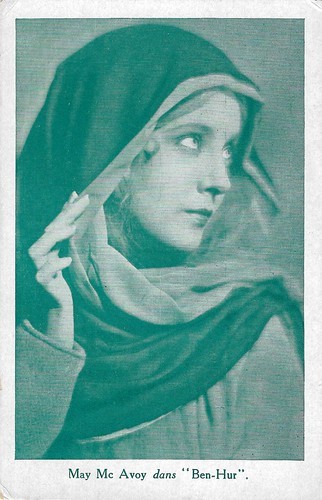
French postcard. This is not May McAvoy but Betty Bronson as the Virgin Mary in Ben-Hur (Fred Niblo 1925). Publicity for the Cinéma Madeleine.
Sources: (IMDb), AllMovie, Wikipedia and .

British Real Photograph postcard.

French postcard by JRPR, Paris, no. 100. Photo: Metro-Goldwyn. Betty Bronson as The Holy Virgin in Ben-Hur (Fred Niblo, 1925).

French postcard by Editions Cinémagazine, no. 226.
Betty Bronson Mania
Elizabeth Ada 'Betty' Bronson was born in Trenton, New Jersey, in 1906, to Frank and Nellie Smith Bronson. She moved to East Orange, New Jersey and attended East Orange High School until she convinced her parents to let her move to California to aid her career in films. Subsequently, the entire family moved to California.
Bronson began her film career at the age of 16 with a bit part in the silent romantic drama Anna Ascends (Victor Fleming, 1922). Alice Brady reprises in the film her starring role from the 1920 Broadway play of the same name about a working class Syrian American waitress who through hard work 'ascends' the social and economic ladder and becomes successful in the United States.
It was followed by more small roles in the silent romantic drama Java Head (George Melford, 1923) starring Leatrice Joy and Jacqueline Logan , the drama His Children's Children (Sam Wood, 1923) starring winsome Bebe Daniels , and The Eternal City (George Fitzmaurice, 1923), starring Barbara La Marr.
At 17, Betty was interviewed by J. M. Barrie, author of 'Peter Pan'. Although the role had been sought by such established actresses as Gloria Swanson and Mary Pickford , Barrie personally chose Bronson to play the lead in the film adaptation of his work, Peter Pan (Herbert Brenon, 1924). She appeared alongside actresses Mary Brian (Wendy Darling) and Esther Ralston (Mrs. Darling), both of whom remained lifelong friends. Ernest Torrence played Captain Hook, Virginia Browne Faire was Tinker Bell, and Chinese-American actress Anna May Wong played the Indian princess Tiger Lily. The film was celebrated at the time for its innovative use of special effects, mainly to show Tinker Bell.
Peter Pan (Herbert Brenon, 1924) closely follows the plot of the original play, and even goes so far as to incorporate much of its original stage dialogue in the intertitles. Added scenes include Nana the dog pouring out Michael's medicine and giving him a bath, and Nana bursting into the home at which a party is being given, to warn Mr. and Mrs. Darling that Peter Pan and the Darling children are flying around the nursery. Like the original play and several other versions, and unlike the 1953 Disney film, the 1924 version makes it clear that Wendy harbours a romantic attachment to Peter, but Peter only thinks of her as his mother.
Camille Scaysbrook at IMDb : "Betty's beautifully expressive performance and unsophisticated looks earned her instant success. For the year following Peter Pan's release, Bronson-mania easily equaled the sort of hysteria previously reserved only for Pickford."
Bronson starred in such films as the comedy Are Parents People? (Malcolm St. Clair 1925) with Florence Vidor and Adolphe Menjou , and Not So Long Ago (Sidney Olcott, 1925) with Ricardo Cortez. She had a small but significant part as The Holy Virgin Mary in the silent film adaptation of Ben-Hur (Fred Niblo, 1925), with Ramon Novarro in the title role.
In 1925, she starred in another J. M. Barrie story, A Kiss for Cinderella (Herbert Brenon, 1925) with Esther Ralston and Tom Moore, an artfully made film that failed at the box office. In only one year the public taste had changed so much as to render the sentimental entertainment of yesteryear obsolete.
Audiences were suddenly more interested in the more adult charms of flappers such as Clara Bow and Colleen Moore . Betty, too, was re-launched as a flapper, sophisticate and occasional period dame in such films as the comedy The Cat's Pajamas (William A. Wellman, 1926) with Ricardo Cortez and Arlette Marchal , and the successful escapist-romance Paradise (Irvin Willat, 1926) with Milton Sills.
Her career was moderately successful but her superstardom had subsided.

German postcard by Ross Verlag, no. 1095/1, 1927-1928. Photo: Paramount-Film.

German postcard by Ross Verlag, no. 1836/1, 1927-1928. Photo: Fanamet.

German postcard by Ross Verlag, no. 2006/1, 1927-1928. Photo: First National / Fanamet. Betty Bronson and Milton Sills acted together in Paradise (Irvin Willat, 1926).

German postcard by Ross Verlag, no. 3804/1, 1928-1929. Photo: Paramount Pictures.
An excellent voice
Betty Bronson made a successful transition into sound films. She sparkled and demonstrated an excellent voice in The Singing Fool (Lloyd Bacon, 1928), co-starring Al Jolson. The part talking film was a follow-up to Jolson's previous film, The Jazz Singer (Alan Crosland, 1927). The Singing Fool is credited with helping to cement the popularity of American films of both sound and the musical genre. Bronson also appeared in the sequel, Sonny Boy (Archie Mayo, 1929), with Davey Lee and Edward Everett Horton.
Bronson was the leading lady opposite vaudeville star Jack Benny in the romantic drama The Medicine Man (Scott Pembroke, 1930). She played the daughter of a shopkeeper who falls in with the leader of a travelling medicine show.
Bronson continued acting until 1933 when she married Ludwig Lauerhass, a well‐to‐do North Carolinian, with whom she had one child, Ludwig Lauerhass, Jr, who later became a lecturer in history emeritus at the University of California, Los Angeles. She did not appear in films again until Yodelin' Kid from Pine Ridge (Joseph Kane, 1937) starring singing cowboy Gene Autry.
In the 1960s, she appeared in episodic television and feature films, such as in Frank Capra's final film, Pocketful of Miracles (1961), starring Bette Davis and Glenn Ford, and Samuel Fuller's Neo Noir The Naked Kiss (1964). Her last screen appearance was an uncredited part in the television biopic Evel Knievel (Marvin J. Chomsky, 1971), starring George Hamilton as motorcycle daredevil Evel Knievel.
In 1971, Betty Bronson died after a protracted illness in Pasadena, California, and was interred at Forest Lawn Memorial Park in Glendale, California. She was 64 and survived by her son, a brother, a sister, and two grandchildren.

Italian postcard by G.B. Falci Editore, Milano, no. 503. Photo: Paramount Films.

Austrian postcard by Iris Verlag, no. 726. Photo: Fanamet-Film.

French postcard. This is not May McAvoy but Betty Bronson as the Virgin Mary in Ben-Hur (Fred Niblo 1925). Publicity for the Cinéma Madeleine.
Sources: (IMDb), AllMovie, Wikipedia and .
Published on August 15, 2019 22:00
August 14, 2019
The Dutch Diva who upset Hollywood
In our Summer series on recent film books, we have another Dutch subject. In 'Diva' Erik Brouwer tells the thrilling tale of the first and only Dutch actress with a star on the Hollywood Walk of Fame. Jetta Goudal (1891-1985) was an exotic and elegant beauty in silent American films in films by Cecil B. De Mille and other legendary directors. She was also an emancipated woman who had the guts to fight for her rights against the film bosses in court. How this ended and how it all began for Goudal in old Amsterdam, Brouwer tells in his well-written and exciting book (sorry, it's in Dutch) .
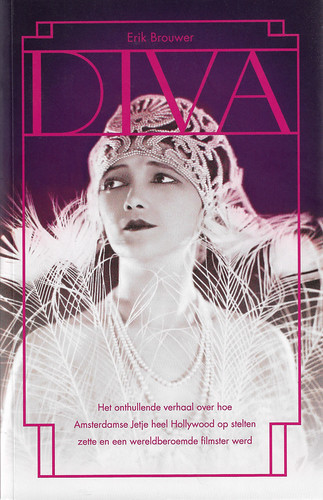
Book cover for Erik Brouwer, 'Diva' (2018). Publisher: Uitgeverij Bern.
A Parisienne from Amsterdam
Jetta Goudal generally described herself as a ‘Parisienne’ and on an information sheet for the Paramount Public Department she later wrote that she was born at Versailles in 1901 as the daughter of Maurice Guillaume Goudal, a lawyer. Her publicist at one point even claimed that she was the daughter of legendary Dutch spy Mata Hari, but no one took that statement seriously, though.
Brouwer describes how she was born ten years earlier as Julie Henriette Goudeket, the daughter of Mozes Goudeket, a wealthy, orthodox Jewish diamond cutter in the Jordaan neighbourhood of Amsterdam.
Tall and regal in appearance, Julie began her acting career on stage, travelling across Europe with various theatre companies. In 1917, Julie Goudeket left a Europe, ravaged by World War I to settle in New York City.
There she hid her Dutch and Jewish ancestry and bluffed her way into Broadway. Goudal first appeared on the New York stage in the drama The Hero by Gilbert Emery in 1921, using the stage name Jetta (pronounced with a French J) Goudal. Later that year she returned with the melodrama The Elton Charm.
She met film director Sidney Olcott in a box at Carnegie Hall, who encouraged her to venture into film acting. She accepted a bit part in his film Timothy's Quest (Sidney Olcott, 1922) as a tubercular mother with children, in a pathetic scene with a drunken husband. Convinced to move to the West Coast, Goudal appeared in two more Olcott films in the ensuing three years.
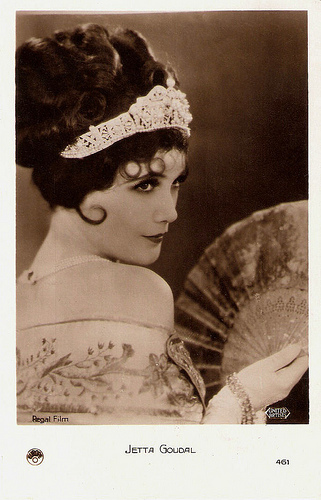
French postcard by Europe, no. 461. Photo: Regal Film / United Artists.
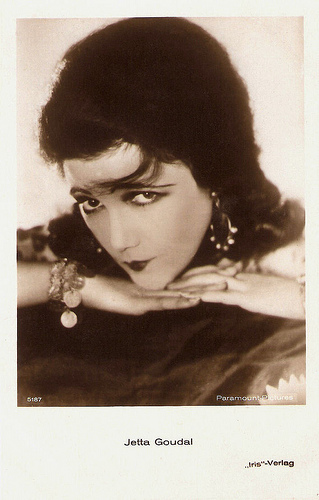
Austrian postcard by Iris-Verlag, no. 5187. Photo: Paramount.

British postcard in the Picturegoer Series, London, no. 273.

British postcard by Real Photograph.
Different and Distinctive
Jetta Goudal's real film debut came in The Bright Shawl (John S. Robertson, 1923) with Richard Barthelmess . Jetta created quite a stir with her striking, exotic appearance in a secondary role as a Chinese/Peruvian spy. Critics found her "different" and "distinctive."
She quickly earned more praise for her following film work, especially for her performance in Salome of the Tenements (Sidney Olcott, 1925), a film based on the Anzia Yezierska novel about life in New York's Jewish Lower East Side. Goudal then worked in the Adolph Zukor and Jesse L. Lasky co-production of The Spaniard (Raoul Walsh, 1925) opposite Ricardo Cortez – ‘the new Sheik’- in his first starring role.
In a documentary by Do Groen at the book's website, film historian Sam Gill explains that film makers chose her because she had an unusual way of gesturing and of talking. Film researcher Joseph Ytansky adds: "She glimmers when you see her on screen. She's absolutely radiant. She has this glowing complexion and that wonderfully slightly evil smile. She's absolutely fantastic."
Her growing fame brought her to the attention of producer/director Cecil B. DeMille. He hired her for what turned out to be some of her (and his) greatest critical successes, including her emotional roles in the highly romantic melodrama The Coming of Amos (Paul Sloane, 1925) starring Rod LaRocque, The Road to Yesterday (Cecil B. DeMille, 1925), the excellent mystery melodrama Three Faces East (Rupert Julian, 1926), the extremely powerful drama White Gold (William K. Howard, 1927) and the lush desert romantic melodrama The Forbidden Woman (Paul L. Stein, 1927) with Victor Varconi .
Jetta had strong convictions about everything in life. She spoke her mind and could be difficult. If she thought something in a film was not real and belonged to the character, she did not want to play it. Reportedly, the famous costume designer Adrian passed out after a costume fitting with her. He collapsed on the floor and people had to help him. Cecil DeMille liked Jetta at first and thought she was a very good actress. Later he claimed that Goudal was so difficult to work with that he eventually fired her and cancelled their contract.
Goudal felt disrespected. It hurt her deeply that she was called unprofessional and Jetta filed a lawsuit for breach of contract against the man who was called 'God' in Hollywood and his DeMille Pictures Corporation. The powerful DeMille claimed her conduct had caused numerous and costly production delays, but in a landmark ruling Goudal won the suit when DeMille was unwilling to provide his studio's financial records to support his claim of financial losses.
Erik Brouwer describes Jetta's long battle against the man, everybody in Hollywood was afraid of. Until her death Goudal was justifiably proud of her victory, it was a milestone. Partly as a result of her efforts Equity was set up. The actors' union would give actors and actresses more legal rights from then on. They would not have to obey any longer to every order issued by producers like De Mille.

German postcard by Ross Verlag, no. 1475/1, 1927-1928. Photo: DPC.
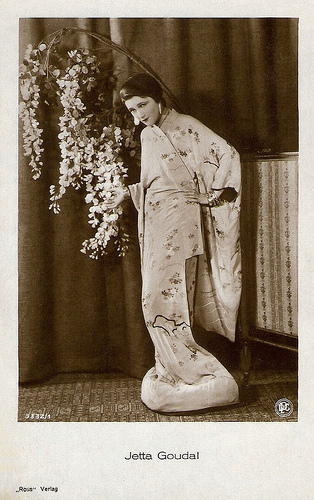
German postcard by Ross Verlag, no. 3332/1, 1928-1929. Photo: DPC.

German postcard by Ross Verlag, no. 3332/2, 1928-1929. Photo: LPG.
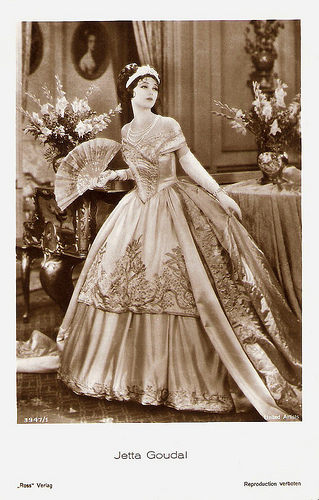
German postcard by Ross Verlag, no. 3947/1, 1928-1929. Photo: United Artists.
Vamp or Joan of Arc?
Jetta Goudal's career was not over after she sued De Mille. She appeared as a vamp opposite Marion Davies and Nils Asther in The Cardboard Lover (Robert Z. Leonard, 1928), produced by William Randolph Hearst and Marion Davies .
In 1929, she starred with Lupe Velez and cowboy star William Boyd in Lady of the Pavements (D.W. Griffith, 1929), a romantic drama set in the time of Napoleon in Paris. At IMDb , reviewer Drednm loves it: "While William Boyd hasn't much to do here as the Count, the two leading ladies tear the place apart. Fiery Lupe Velez is superb as Nanon, taking full advantage of the comic scenes but then turning in a terrific dramatic performance in the finale. Jetta Goudal is gorgeous and lethal as Diane, using her haughty beauty to good effect."
The next year Jacques Feyder directed Goudal in her only French language film, Le Spectre vert/The Green Spectre (Jacques Feyder, 1930), a made-in-Hollywood, alternate language version of The Unholy Night (1929).
Because of her audaciousness in suing DeMille and her high-profile activism in the Actors Equity's fight for the unionisation of film actors she became known as 'the Joan of Arc of Equity'. Some of the Hollywood studios refused to employ 'the Bolshewist of the Movie Industry' and with the arrival of sound her thick accent left her with limited offers.
At age forty-one, she made her last screen appearance in a talkie, the comedy Business and Pleasure (David Butler, 1932), co-starring with Will Rogers. In 1930, she had married Harold Grieve, an art director and founding member of the Academy of Motion Picture Arts and Sciences. Along with her husband, she went into interior design and faded from the Hollywood scene. They had no children.
Plagued by health problems (heart condition) in the 1960s, she suffered a serious fall in 1973 which left her virtually an invalid. She told an interviewer in 1985: "I don't like being called a silent star. Who was silent? I was never silent!" Shortly after, Jetta Goudal died in 1985 in Los Angeles, at age 94.
Erik Brouwer makes clear what a complicated person Jetta Goudal was. She was a perfectionist, which hounded her. She had her demons. About De Mille she said that she trusted him like a father. She was so upset by his actions that she was in a hospital for a year. She never wrote to her real conservative Jewish father, not even after her mother had died in 1921.
The title of the book is well chosen. Jetta Goudal was a diva. She would often throw fits and just walk off. But she was also a kind person. Film historian Anthony Slide explains in the documentary that "difficulty was part of her make-up." She demanded perfection like she wanted perfection in the things around her. Playing the role of being Jetta Goudal must have been difficult. But, as a friend says: "It was something magnificent to be."
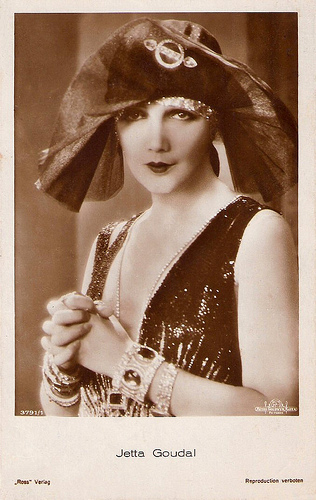
German postcard by Ross Verlag, no. 3791/1, 1928-1929. Photo: MGM (Metro Goldwyn Mayer).

French postcard.
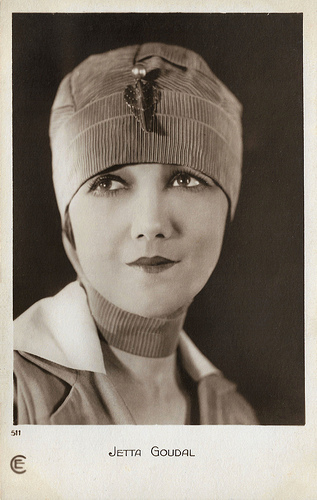
French postcard by Cinémagazine-Édition, Paris, no. 511.
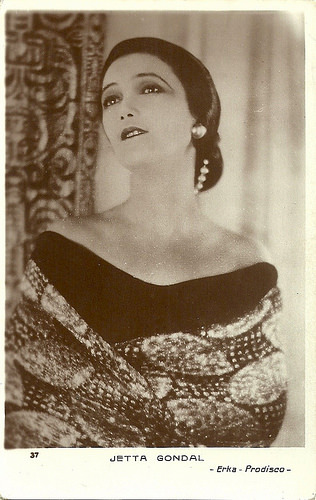
French postcard, no. 37. Photo: Erka-Prodisco. Erka-Prodisco Films was a French film distribution company. Her name is erroneously written as Jetta Gondal.
Sources: Erik Brouwer (Diva - Dutch), Charles C. Benham (Classic Images), Hans J. Wollstein (AllMovie), Operator_99 (Allure), (IMDb), Wikipedia, and .

Book cover for Erik Brouwer, 'Diva' (2018). Publisher: Uitgeverij Bern.
A Parisienne from Amsterdam
Jetta Goudal generally described herself as a ‘Parisienne’ and on an information sheet for the Paramount Public Department she later wrote that she was born at Versailles in 1901 as the daughter of Maurice Guillaume Goudal, a lawyer. Her publicist at one point even claimed that she was the daughter of legendary Dutch spy Mata Hari, but no one took that statement seriously, though.
Brouwer describes how she was born ten years earlier as Julie Henriette Goudeket, the daughter of Mozes Goudeket, a wealthy, orthodox Jewish diamond cutter in the Jordaan neighbourhood of Amsterdam.
Tall and regal in appearance, Julie began her acting career on stage, travelling across Europe with various theatre companies. In 1917, Julie Goudeket left a Europe, ravaged by World War I to settle in New York City.
There she hid her Dutch and Jewish ancestry and bluffed her way into Broadway. Goudal first appeared on the New York stage in the drama The Hero by Gilbert Emery in 1921, using the stage name Jetta (pronounced with a French J) Goudal. Later that year she returned with the melodrama The Elton Charm.
She met film director Sidney Olcott in a box at Carnegie Hall, who encouraged her to venture into film acting. She accepted a bit part in his film Timothy's Quest (Sidney Olcott, 1922) as a tubercular mother with children, in a pathetic scene with a drunken husband. Convinced to move to the West Coast, Goudal appeared in two more Olcott films in the ensuing three years.

French postcard by Europe, no. 461. Photo: Regal Film / United Artists.

Austrian postcard by Iris-Verlag, no. 5187. Photo: Paramount.

British postcard in the Picturegoer Series, London, no. 273.

British postcard by Real Photograph.
Different and Distinctive
Jetta Goudal's real film debut came in The Bright Shawl (John S. Robertson, 1923) with Richard Barthelmess . Jetta created quite a stir with her striking, exotic appearance in a secondary role as a Chinese/Peruvian spy. Critics found her "different" and "distinctive."
She quickly earned more praise for her following film work, especially for her performance in Salome of the Tenements (Sidney Olcott, 1925), a film based on the Anzia Yezierska novel about life in New York's Jewish Lower East Side. Goudal then worked in the Adolph Zukor and Jesse L. Lasky co-production of The Spaniard (Raoul Walsh, 1925) opposite Ricardo Cortez – ‘the new Sheik’- in his first starring role.
In a documentary by Do Groen at the book's website, film historian Sam Gill explains that film makers chose her because she had an unusual way of gesturing and of talking. Film researcher Joseph Ytansky adds: "She glimmers when you see her on screen. She's absolutely radiant. She has this glowing complexion and that wonderfully slightly evil smile. She's absolutely fantastic."
Her growing fame brought her to the attention of producer/director Cecil B. DeMille. He hired her for what turned out to be some of her (and his) greatest critical successes, including her emotional roles in the highly romantic melodrama The Coming of Amos (Paul Sloane, 1925) starring Rod LaRocque, The Road to Yesterday (Cecil B. DeMille, 1925), the excellent mystery melodrama Three Faces East (Rupert Julian, 1926), the extremely powerful drama White Gold (William K. Howard, 1927) and the lush desert romantic melodrama The Forbidden Woman (Paul L. Stein, 1927) with Victor Varconi .
Jetta had strong convictions about everything in life. She spoke her mind and could be difficult. If she thought something in a film was not real and belonged to the character, she did not want to play it. Reportedly, the famous costume designer Adrian passed out after a costume fitting with her. He collapsed on the floor and people had to help him. Cecil DeMille liked Jetta at first and thought she was a very good actress. Later he claimed that Goudal was so difficult to work with that he eventually fired her and cancelled their contract.
Goudal felt disrespected. It hurt her deeply that she was called unprofessional and Jetta filed a lawsuit for breach of contract against the man who was called 'God' in Hollywood and his DeMille Pictures Corporation. The powerful DeMille claimed her conduct had caused numerous and costly production delays, but in a landmark ruling Goudal won the suit when DeMille was unwilling to provide his studio's financial records to support his claim of financial losses.
Erik Brouwer describes Jetta's long battle against the man, everybody in Hollywood was afraid of. Until her death Goudal was justifiably proud of her victory, it was a milestone. Partly as a result of her efforts Equity was set up. The actors' union would give actors and actresses more legal rights from then on. They would not have to obey any longer to every order issued by producers like De Mille.

German postcard by Ross Verlag, no. 1475/1, 1927-1928. Photo: DPC.

German postcard by Ross Verlag, no. 3332/1, 1928-1929. Photo: DPC.

German postcard by Ross Verlag, no. 3332/2, 1928-1929. Photo: LPG.

German postcard by Ross Verlag, no. 3947/1, 1928-1929. Photo: United Artists.
Vamp or Joan of Arc?
Jetta Goudal's career was not over after she sued De Mille. She appeared as a vamp opposite Marion Davies and Nils Asther in The Cardboard Lover (Robert Z. Leonard, 1928), produced by William Randolph Hearst and Marion Davies .
In 1929, she starred with Lupe Velez and cowboy star William Boyd in Lady of the Pavements (D.W. Griffith, 1929), a romantic drama set in the time of Napoleon in Paris. At IMDb , reviewer Drednm loves it: "While William Boyd hasn't much to do here as the Count, the two leading ladies tear the place apart. Fiery Lupe Velez is superb as Nanon, taking full advantage of the comic scenes but then turning in a terrific dramatic performance in the finale. Jetta Goudal is gorgeous and lethal as Diane, using her haughty beauty to good effect."
The next year Jacques Feyder directed Goudal in her only French language film, Le Spectre vert/The Green Spectre (Jacques Feyder, 1930), a made-in-Hollywood, alternate language version of The Unholy Night (1929).
Because of her audaciousness in suing DeMille and her high-profile activism in the Actors Equity's fight for the unionisation of film actors she became known as 'the Joan of Arc of Equity'. Some of the Hollywood studios refused to employ 'the Bolshewist of the Movie Industry' and with the arrival of sound her thick accent left her with limited offers.
At age forty-one, she made her last screen appearance in a talkie, the comedy Business and Pleasure (David Butler, 1932), co-starring with Will Rogers. In 1930, she had married Harold Grieve, an art director and founding member of the Academy of Motion Picture Arts and Sciences. Along with her husband, she went into interior design and faded from the Hollywood scene. They had no children.
Plagued by health problems (heart condition) in the 1960s, she suffered a serious fall in 1973 which left her virtually an invalid. She told an interviewer in 1985: "I don't like being called a silent star. Who was silent? I was never silent!" Shortly after, Jetta Goudal died in 1985 in Los Angeles, at age 94.
Erik Brouwer makes clear what a complicated person Jetta Goudal was. She was a perfectionist, which hounded her. She had her demons. About De Mille she said that she trusted him like a father. She was so upset by his actions that she was in a hospital for a year. She never wrote to her real conservative Jewish father, not even after her mother had died in 1921.
The title of the book is well chosen. Jetta Goudal was a diva. She would often throw fits and just walk off. But she was also a kind person. Film historian Anthony Slide explains in the documentary that "difficulty was part of her make-up." She demanded perfection like she wanted perfection in the things around her. Playing the role of being Jetta Goudal must have been difficult. But, as a friend says: "It was something magnificent to be."

German postcard by Ross Verlag, no. 3791/1, 1928-1929. Photo: MGM (Metro Goldwyn Mayer).

French postcard.

French postcard by Cinémagazine-Édition, Paris, no. 511.

French postcard, no. 37. Photo: Erka-Prodisco. Erka-Prodisco Films was a French film distribution company. Her name is erroneously written as Jetta Gondal.
Sources: Erik Brouwer (Diva - Dutch), Charles C. Benham (Classic Images), Hans J. Wollstein (AllMovie), Operator_99 (Allure), (IMDb), Wikipedia, and .
Published on August 14, 2019 22:00
August 13, 2019
Carla Rust
Carla Rust (1908-1977) was a blonde German film actress. She appeared as a leading lady in a number of light entertainment films during the Nazi era. She was married to the actor Sepp Rist.
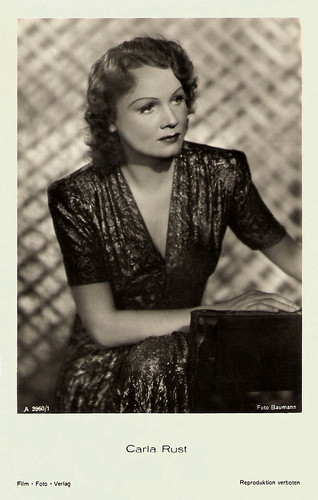
German postcard by Film-Foto-Verlag, no. A 3960/1, 1941-1944. Photo: Baumann.
Star-studded musical in Busby Berkeley-style
Carla Rust was born in Burgdamm near Bremen, Germany, in 1908. The blonde actress appeared on stage from 1928.
She started her film career with small roles in such films as the drama Nur nicht weich werden, Susanne!/Don't Lose Heart, Suzanne! (Arzén von Cserépy, 1935) starring Jessie Vihrog and Veit Harlan , and the musical drama Ein Lied klagt an/The Accusing Song (Georg Zoch, 1936) with Louis Graveure and Gina Falckenberg.
She had a supporting part in the Gustave Flaubert adaptation Madame Bovary (Gerhard Lamprecht, 1937) starring Pola Negri .
Rust played the central role in the musical revue Es leuchten die Sterne/The Stars Shine (Hans H. Zerlett, 1938). She was a young secretary who travels to Berlin to seek work as an actress. In a comedy of errors, she is mistaken for a famous dancer, which results in her heading the cast of a star-studded musical in Busby Berkeley-style.
The plot was a backdrop for this musical revue film, set as a musical set inside a film studio. Rust headed a cast which included many German stage, sports, and Tobis film stars of the 1930s. Joseph Goebbels, the Nazi Propaganda Minister had commissioned the film to act as a propaganda piece promoting the Third Reich as a cultural entity.
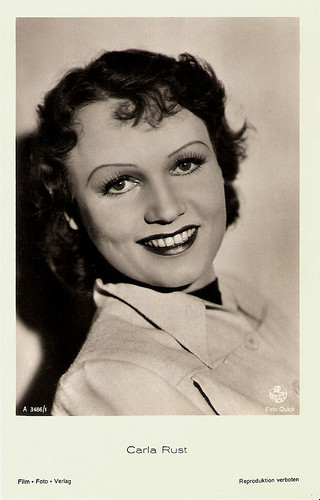
German postcard by Film-Foto-Verlag, no. A 3486/1, 1941-1944. Photo: Terra / Quick.
Big German card by Ross-Verlag. Photo: Terra. Carla Rust and Luis Trenker in Liebesbriefe aus dem Engadin/Love Letters from the Engadine (Werner Klingler, 1938).
The only anti-Semitic musical comedy released during the Nazi era
Carla Rust co-starred with Mountain Film star Luis Trenker in the romantic comedy Liebesbriefe aus dem Engadin/Love Letters from Engadin or Love Letters from the Engadine (Luis Trenker, Werner Klingler, 1939), set in London and in the Engadin valley in the Swiss Alps, where much of the location shooting took place.
She then costarred with Italian tenor Beniamino Gigli in the Italian comedy Marionette (Carmine Gallone, 1939).
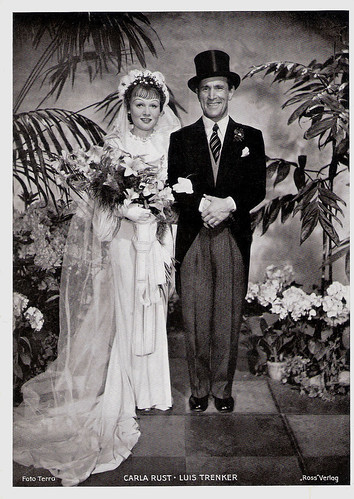 Then followed the German musical comedy Robert und Bertram/Robert and Bertram (Hans Heinz Zerlett, 1939) with Rudi Godden and Kurt Seifert. It was based on the 1856 play 'Robert and Bertram' by Gustav Räder about two wandering vagrants, and it was the only anti-Semitic musical comedy released during the Nazi era and the first film since Kristallnacht to focus on Jews as cultural and economic outsiders.
Then followed the German musical comedy Robert und Bertram/Robert and Bertram (Hans Heinz Zerlett, 1939) with Rudi Godden and Kurt Seifert. It was based on the 1856 play 'Robert and Bertram' by Gustav Räder about two wandering vagrants, and it was the only anti-Semitic musical comedy released during the Nazi era and the first film since Kristallnacht to focus on Jews as cultural and economic outsiders.
In 1943, she appeared opposite Anny Ondra in Himmel, wir erben ein Schloß/Heaven, We Inherit a Castle (Peter Paul Brauer, 1943). It was Ondra's last starring role, and the film was shot in German-occupied Prague, Ondra's hometown, by the Prag-Film company.
After the war, the film engagements halted fot Rust. During the 1950s, she returned in small parts in West-German productions like the romantic drama Die schöne Müllerin/The Beautiful Miller (Wolfgang Liebeneiner, 1954) starring Waltraut Haas and Gerhard Riedmann , the drama Oberarzt Dr. Solm/Doctor Solm (Paul May, 1955) featuring Hans Söhnker , and the comedy Heute heiratet mein Mann/My Husband's Getting Married Today (Kurt Hoffmann, 1956) starring Liselotte Pulver and Johannes Heesters .
After Der Adler vom Velsatal/The Eagle of Velsa Valley (Richard Häussler, 1957), she retired from the film business. Carla Rust passed away in 1977 in Hindelang, Bavaria, West Germany. She was 69.
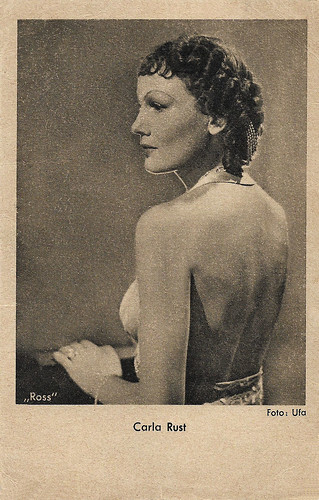
German postcard by Das Programm von Heute, Berlin. Photo: Ross / Ufa.
Sources: Wikipedia and .

German postcard by Film-Foto-Verlag, no. A 3960/1, 1941-1944. Photo: Baumann.
Star-studded musical in Busby Berkeley-style
Carla Rust was born in Burgdamm near Bremen, Germany, in 1908. The blonde actress appeared on stage from 1928.
She started her film career with small roles in such films as the drama Nur nicht weich werden, Susanne!/Don't Lose Heart, Suzanne! (Arzén von Cserépy, 1935) starring Jessie Vihrog and Veit Harlan , and the musical drama Ein Lied klagt an/The Accusing Song (Georg Zoch, 1936) with Louis Graveure and Gina Falckenberg.
She had a supporting part in the Gustave Flaubert adaptation Madame Bovary (Gerhard Lamprecht, 1937) starring Pola Negri .
Rust played the central role in the musical revue Es leuchten die Sterne/The Stars Shine (Hans H. Zerlett, 1938). She was a young secretary who travels to Berlin to seek work as an actress. In a comedy of errors, she is mistaken for a famous dancer, which results in her heading the cast of a star-studded musical in Busby Berkeley-style.
The plot was a backdrop for this musical revue film, set as a musical set inside a film studio. Rust headed a cast which included many German stage, sports, and Tobis film stars of the 1930s. Joseph Goebbels, the Nazi Propaganda Minister had commissioned the film to act as a propaganda piece promoting the Third Reich as a cultural entity.

German postcard by Film-Foto-Verlag, no. A 3486/1, 1941-1944. Photo: Terra / Quick.
Big German card by Ross-Verlag. Photo: Terra. Carla Rust and Luis Trenker in Liebesbriefe aus dem Engadin/Love Letters from the Engadine (Werner Klingler, 1938).
The only anti-Semitic musical comedy released during the Nazi era
Carla Rust co-starred with Mountain Film star Luis Trenker in the romantic comedy Liebesbriefe aus dem Engadin/Love Letters from Engadin or Love Letters from the Engadine (Luis Trenker, Werner Klingler, 1939), set in London and in the Engadin valley in the Swiss Alps, where much of the location shooting took place.
She then costarred with Italian tenor Beniamino Gigli in the Italian comedy Marionette (Carmine Gallone, 1939).
 Then followed the German musical comedy Robert und Bertram/Robert and Bertram (Hans Heinz Zerlett, 1939) with Rudi Godden and Kurt Seifert. It was based on the 1856 play 'Robert and Bertram' by Gustav Räder about two wandering vagrants, and it was the only anti-Semitic musical comedy released during the Nazi era and the first film since Kristallnacht to focus on Jews as cultural and economic outsiders.
Then followed the German musical comedy Robert und Bertram/Robert and Bertram (Hans Heinz Zerlett, 1939) with Rudi Godden and Kurt Seifert. It was based on the 1856 play 'Robert and Bertram' by Gustav Räder about two wandering vagrants, and it was the only anti-Semitic musical comedy released during the Nazi era and the first film since Kristallnacht to focus on Jews as cultural and economic outsiders. In 1943, she appeared opposite Anny Ondra in Himmel, wir erben ein Schloß/Heaven, We Inherit a Castle (Peter Paul Brauer, 1943). It was Ondra's last starring role, and the film was shot in German-occupied Prague, Ondra's hometown, by the Prag-Film company.
After the war, the film engagements halted fot Rust. During the 1950s, she returned in small parts in West-German productions like the romantic drama Die schöne Müllerin/The Beautiful Miller (Wolfgang Liebeneiner, 1954) starring Waltraut Haas and Gerhard Riedmann , the drama Oberarzt Dr. Solm/Doctor Solm (Paul May, 1955) featuring Hans Söhnker , and the comedy Heute heiratet mein Mann/My Husband's Getting Married Today (Kurt Hoffmann, 1956) starring Liselotte Pulver and Johannes Heesters .
After Der Adler vom Velsatal/The Eagle of Velsa Valley (Richard Häussler, 1957), she retired from the film business. Carla Rust passed away in 1977 in Hindelang, Bavaria, West Germany. She was 69.

German postcard by Das Programm von Heute, Berlin. Photo: Ross / Ufa.
Sources: Wikipedia and .
Published on August 13, 2019 22:00
August 12, 2019
Das Abenteuer der Sibylle Brant (1925)
In our continuing series of Henny Porten film specials, EFSP presents the German silent film Das Abenteuer der Sibylle Brant/The Adventures of Sybil Brent (Carl Froehlich, 1925). It was again a Henny Porten-Froehlich-Produktion, starring Porten and Italian film star Memo Benassi. In this post we focus on the studio where the film was produced.
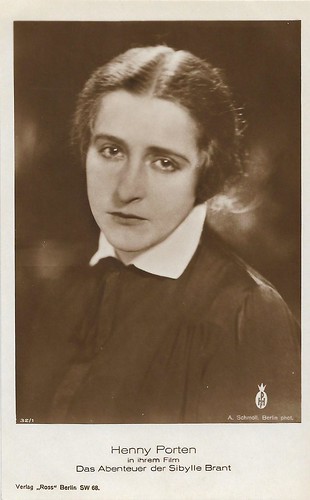
German postcard by Ross Verlag, no. 32/1. Photo: A. Schmoll, Berlin / Henny Porten-Froehlich-Produktion. Henny Porten in Das Abenteuer der Sibylle Brant/The Adventures of Sybil Brent (Carl Froehlich, 1925).
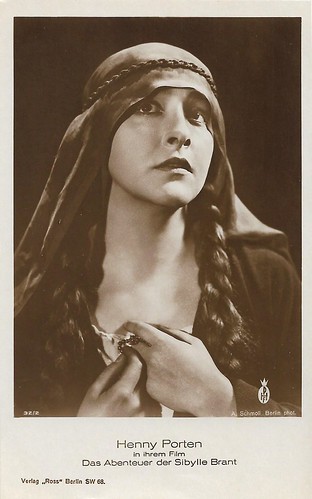
German postcard by Ross Verlag, no. 32/2. Photo: A. Schmoll, Berlin / Henny Porten-Froehlich-Produktion. Henny Porten in Das Abenteuer der Sibylle Brant/The Adventures of Sybil Brent (Carl Froehlich, 1925).
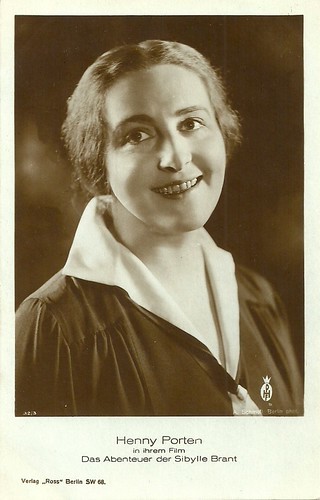
German postcard by Ross Verlag, no. 32/3. Photo: A. Schmoll, Berlin / Henny Porten-Froehlich-Produktion. Henny Porten in Das Abenteuer der Sibylle Brant/The Adventures of Sybil Brent (Carl Froehlich, 1925).
The Zoo-Atelier studio
Das Abenteuer der Sibylle Brant aka Das Abenteuer der Sibylle Brandt was filmed at the Zoo-Atelier film studio in the Hardenbergstraße in Berlin. Zoo-Atelier was founded in 1919 and was situated in former exhibition halls, transformed into a studio by the furniture manufacturer Markiewicz.
As the Cinegraph Lexicon mentions, among its first clients was Goron-Films, for which Friedrich Wilhelm Murnau staged the films Der Januskopf/Love's Mockery (1920) with Conrad Veidt , and Der Gang in der Nacht/Journey Into the Night (1921) with Olaf Fonss , Conrad Veidt and Erna Morena , at the Zoo-Atelier (and the Cserépy-Atelier in Leipziger Strasse).
From 1921 the studio was rented by the Europäische Film-Allianz (E.F.A.) GmbH, run by film producers Paul Davidson (formerly PAGU), Carl Bratz, and Adolf Zukor (Famous Players-Lasky). They soon turned it into one of the best equipped and most favoured studios of the early 1920s in Europe.
In the following years, several famous films by German directors were shot at the Zoo-Atelier: Ernst Lubitsch 's Das Weib des Pharao/The Wife of the Pharaoh (1920) and Die Flamme/The Flame (1922), Richard Oswald's Carlos und Elisabeth/Carlos and Elisabeth (1923/24), Joe May's Tragödie der Liebe/Tragedy of Love (1922/1923, also at the May-Atelier) and Nju (Paul Czinner, 1924, also at Staaken), Peter Paul Felner's Der Kaufmann von Venedig/The Merchant of Venice (1923) and Das goldene Kalb/The Golden Calf (1924).
Carl Froelich filmed here the dramas Mutter und Kind/Mother and Child (1924) and Das Abenteuer der Sibylle Brant/The Adventures of Sybil Brent (1925), both starring Henny Porten . Their Henny Porten-Froelich Produktion was one of the regular clients of the studio.
When Zukor backed out of the studio in 1924, E.F.A. was overtaken by Cob-Film. The following year, when the rental contract with Zoo-Atelier expired, the company built its own EFA-Atelier at Cicerostraße. And that was the end of the Zoo-Atelier.
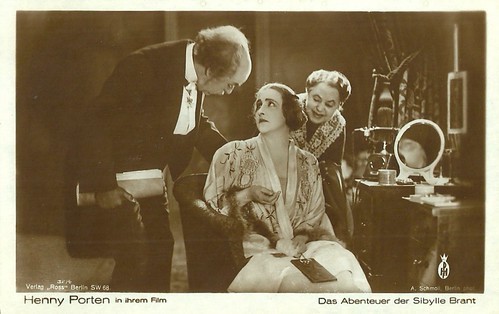
German postcard by Ross Verlag, no. 32/4. Photo: A. Schmoll, Berlin / Henny Porten-Froehlich-Produktion. Henny Porten in Das Abenteuer der Sibylle Brant/The Adventures of Sybil Brent (Carl Froehlich, 1925). The man could be A.E. Licho, who plays a theatre director.
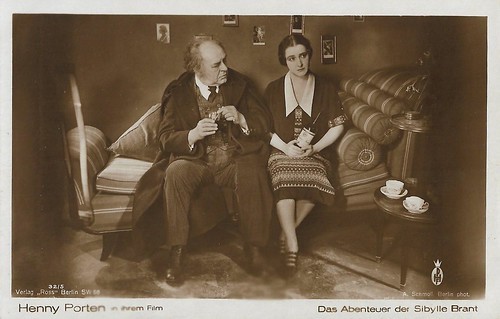
German postcard by Ross Verlag, no. 32/5. Photo: A. Schmoll, Berlin / Henny Porten-Froehlich-Produktion. Henny Porten in Das Abenteuer der Sibylle Brant/The Adventures of Sybil Brent (Carl Froehlich, 1925). The man could be Rudolf Biebrach, who played Sibylle's father in the film.
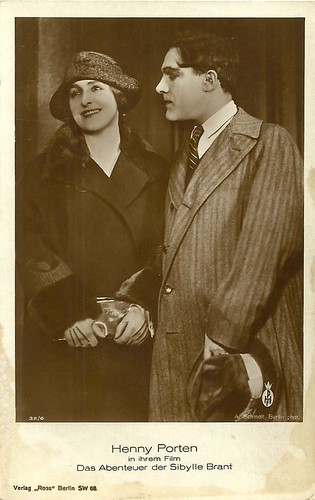
German postcard by Ross Verlag, no. 32/6. Photo: A. Schmoll, Berlin / Henny Porten-Froehlich-Produktion. Henny Porten and Memo Benassi in Das Abenteuer der Sibylle Brant/The Adventures of Sybil Brent (Carl Froehlich, 1925).
Source: Cinegraph (German), Wikipedia and IMDb.

German postcard by Ross Verlag, no. 32/1. Photo: A. Schmoll, Berlin / Henny Porten-Froehlich-Produktion. Henny Porten in Das Abenteuer der Sibylle Brant/The Adventures of Sybil Brent (Carl Froehlich, 1925).

German postcard by Ross Verlag, no. 32/2. Photo: A. Schmoll, Berlin / Henny Porten-Froehlich-Produktion. Henny Porten in Das Abenteuer der Sibylle Brant/The Adventures of Sybil Brent (Carl Froehlich, 1925).

German postcard by Ross Verlag, no. 32/3. Photo: A. Schmoll, Berlin / Henny Porten-Froehlich-Produktion. Henny Porten in Das Abenteuer der Sibylle Brant/The Adventures of Sybil Brent (Carl Froehlich, 1925).
The Zoo-Atelier studio
Das Abenteuer der Sibylle Brant aka Das Abenteuer der Sibylle Brandt was filmed at the Zoo-Atelier film studio in the Hardenbergstraße in Berlin. Zoo-Atelier was founded in 1919 and was situated in former exhibition halls, transformed into a studio by the furniture manufacturer Markiewicz.
As the Cinegraph Lexicon mentions, among its first clients was Goron-Films, for which Friedrich Wilhelm Murnau staged the films Der Januskopf/Love's Mockery (1920) with Conrad Veidt , and Der Gang in der Nacht/Journey Into the Night (1921) with Olaf Fonss , Conrad Veidt and Erna Morena , at the Zoo-Atelier (and the Cserépy-Atelier in Leipziger Strasse).
From 1921 the studio was rented by the Europäische Film-Allianz (E.F.A.) GmbH, run by film producers Paul Davidson (formerly PAGU), Carl Bratz, and Adolf Zukor (Famous Players-Lasky). They soon turned it into one of the best equipped and most favoured studios of the early 1920s in Europe.
In the following years, several famous films by German directors were shot at the Zoo-Atelier: Ernst Lubitsch 's Das Weib des Pharao/The Wife of the Pharaoh (1920) and Die Flamme/The Flame (1922), Richard Oswald's Carlos und Elisabeth/Carlos and Elisabeth (1923/24), Joe May's Tragödie der Liebe/Tragedy of Love (1922/1923, also at the May-Atelier) and Nju (Paul Czinner, 1924, also at Staaken), Peter Paul Felner's Der Kaufmann von Venedig/The Merchant of Venice (1923) and Das goldene Kalb/The Golden Calf (1924).
Carl Froelich filmed here the dramas Mutter und Kind/Mother and Child (1924) and Das Abenteuer der Sibylle Brant/The Adventures of Sybil Brent (1925), both starring Henny Porten . Their Henny Porten-Froelich Produktion was one of the regular clients of the studio.
When Zukor backed out of the studio in 1924, E.F.A. was overtaken by Cob-Film. The following year, when the rental contract with Zoo-Atelier expired, the company built its own EFA-Atelier at Cicerostraße. And that was the end of the Zoo-Atelier.

German postcard by Ross Verlag, no. 32/4. Photo: A. Schmoll, Berlin / Henny Porten-Froehlich-Produktion. Henny Porten in Das Abenteuer der Sibylle Brant/The Adventures of Sybil Brent (Carl Froehlich, 1925). The man could be A.E. Licho, who plays a theatre director.

German postcard by Ross Verlag, no. 32/5. Photo: A. Schmoll, Berlin / Henny Porten-Froehlich-Produktion. Henny Porten in Das Abenteuer der Sibylle Brant/The Adventures of Sybil Brent (Carl Froehlich, 1925). The man could be Rudolf Biebrach, who played Sibylle's father in the film.

German postcard by Ross Verlag, no. 32/6. Photo: A. Schmoll, Berlin / Henny Porten-Froehlich-Produktion. Henny Porten and Memo Benassi in Das Abenteuer der Sibylle Brant/The Adventures of Sybil Brent (Carl Froehlich, 1925).
Source: Cinegraph (German), Wikipedia and IMDb.
Published on August 12, 2019 22:00
August 11, 2019
Jacob Sisters
The Geschwister Jacob or Jacob Sisters was a group of four, later three German sisters who sang Schlager songs. The sisters were Johanna (1939-2015), Rosi (1941), Eva (1943) and Hannelore Jacob (1944-2008). After Hannelore Jacob's death, but also occasionally in earlier times, the group appeared as a trio.
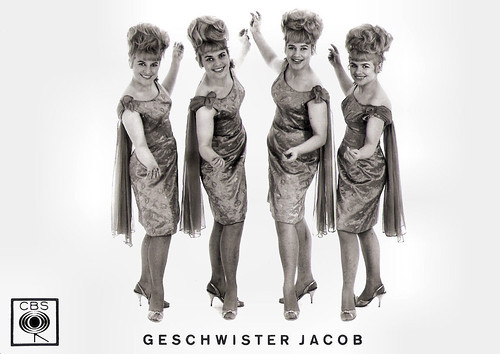
German promotion card, no. 5/60. Photo: CBS.
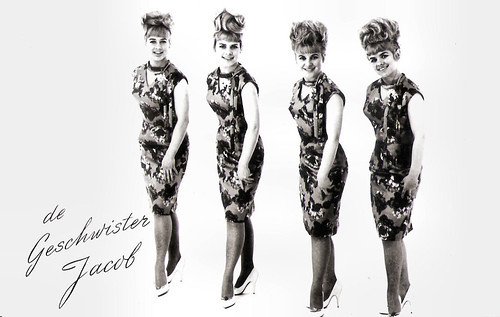
Dutch postcard by Muziek Parade, Hilversum, no. AX 6254.
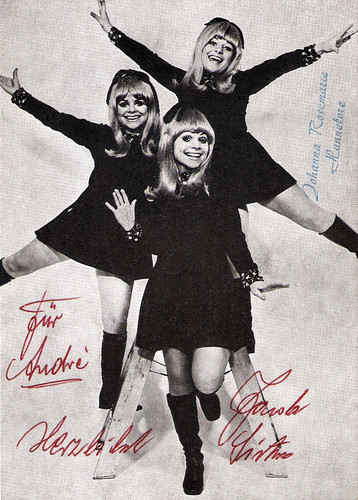
German autograph card by M-Rekord. Pictured are Johanna, Rosemarie and Hannelore.
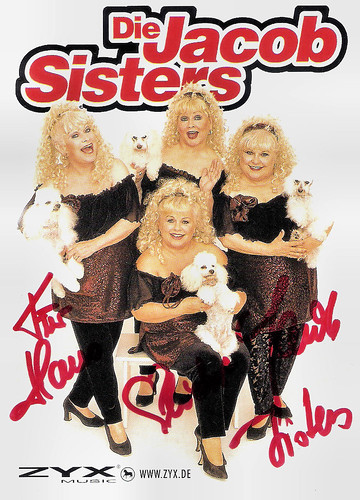
German autograph card by Zyx Music.
White Poodles
The Jacob Sisters (in German: geschwister Jacob) come from the Saxon Schmannewitz (municipality Dahlen).
Already in childhood they started their common career as the 'Schmannewitzer Heidelerchen' in the Café Jacob in Schmannewitz. Later, they appeared in and around Leipzig. They attended the Musikhochschule Weimar (Weimar Music Academy), moved to the Federal Republic in 1958 and continued their studies in Frankfurt am Main.
Lia Wöhr gave them an appearance on the television program Zum Blauen Bock. In 1963 they had their greatest success in Germany with the 'Gartenzwerg-Marsch' (Garden gnome march), a cover version of a song of British singer Billy Sanders. At that time they still called themselves the Geschwister Jacob.
In 1966 they took part in the German Schlager Festival. Their song 'So ist ein Boy' came in at the eights place. Their biggest international successes have been appearances in Las Vegas and New York in the 1960s. There they performed with Louis Armstrong , Sammy Davis Jr. and Duke Ellington. From then on, they called themselves Jacob Sisters.
Since 1960, they are accompanied during their performances by white poodles that have become their trademark. Their hits included 'Träume der Liebe' (1964), 'Am blauen See im grünen Tal' (1965), 'Gartenzwerg-Marsch' (1965), 'Was hab`ich Dir getan' (1965) and 'Auf dem Wege nach Aschaffenburg' (1969).
During the 1960s, they also performed in several films, such as Dr. Murkes gesammelte Nachrufe/Dr. Murkes collected obituaries (Rolf Hädrich, 1965) with Dieter Hildebrandt and Dieter Borsche , and the comedy Quartett im Bett/Quartet in Bed (Ulrich Schamoni, 1968). For their performances in the latter film they won the Ernst Lubitsch Preis.
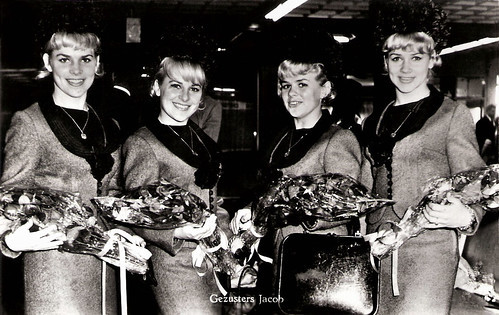
Dutch postcard by Gebr. Spanjersberg N.V., Rotterdam (SPARO), no. 1245. The Jacob Sisters at Schiphol during their visit to the Netherlands in 1965.
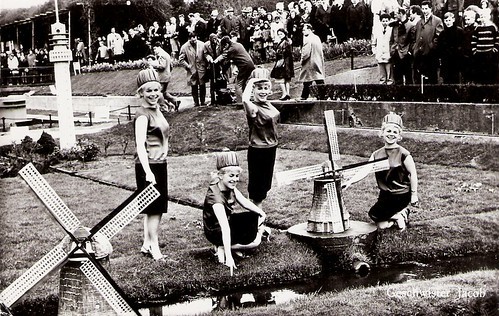
Dutch postcard by Hercules, Haarlem, no. 1350 A. Photo: CBS. The Geschwister Jacob during a visit of miniature town Madurodam in Den Haag (The Haghe), The Netherlands.
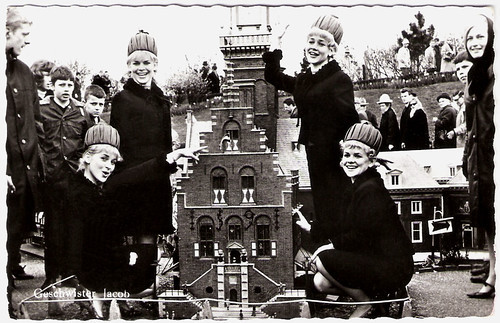
Dutch postcard by N.V. v.h. Weenenk & Snel, Baarn. Sent by mail in 1966. Photo: CBS. The Jacob Sisters during a visit of miniature town Madurodam in The Haghe.
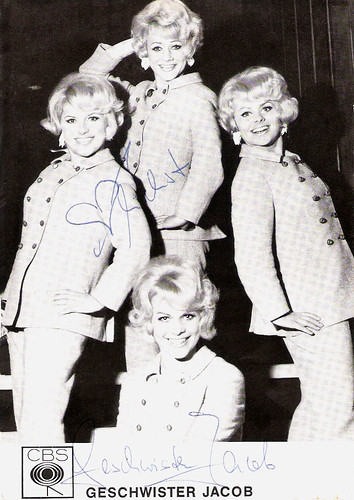
German promotion card by CBS.
I am a star - get me out of here!
Through the years, the Jacob Sisters became a hilarious cult phenomenon. Their songs included parodies on hits like 'Sonderzug nach Pankow', 'Pariser Tango' and 'Yes Sir, I Can Boogie'. At the end of the 1990s and the beginning of the 2000s, the Jacob Sisters appeared several times as star guests at the Madame Lothár Theater in Bremen, where they also took part in a gala show in June 2002 on the occasion of the tenth anniversary of the theatre.
They often appeared on German television and radio, especially in folk music programs such as in the TV series Feste der Volksmusik, Lieder sind die besten Freunde (Songs are the best friends) and Musikantenstadl, but also in many other shows. They also persormed in the TV series Ein Heim für Tiere/The Adventures of Dr. Bayer (1987) and the Krimi series Die Kommissarin/Lady Cop (1995), featuring Hannelore Elsner .
With the Techno song 'The Hampster Dance' (2001), the four sisters even reached the top of the Canadian charts. They also appeared in the film comedy Ausziehn!/Undress! (Peter Morlock, 2001) with Désirée Nick and Evelyn Künneke , and in the TV series Polly Adler (2008).
In 2008 Hannelore Jacob died of heart failure as a result of pneumonia. In 2011 Eva Jacob participated in the 5th season of the RTL show Ich bin ein Star – Holt mich hier raus! (I am a star - get me out of here!).
Johanna Jacob died on in 2015 in Sana Klinikum Offenbach from the effects of a stroke. She was buried next to her sister Hannelore on the forest cemetery Buchenbusch. The remaining Jacob sisters, Eva and Rosi are still going strong.
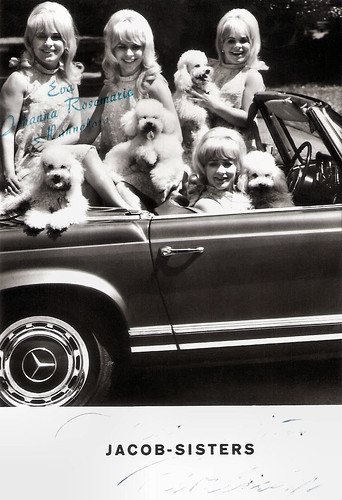
German promotion card by Becker autoradio. Caption: With a Becker autoradio, you can also listen perfectly in your car to the Jacob Sisters.
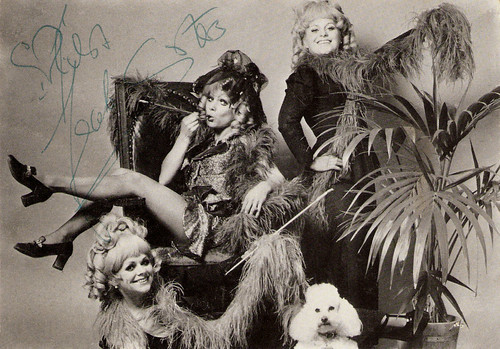
German promotion card by M-Records (Music Records), München. Photo: M-Records.
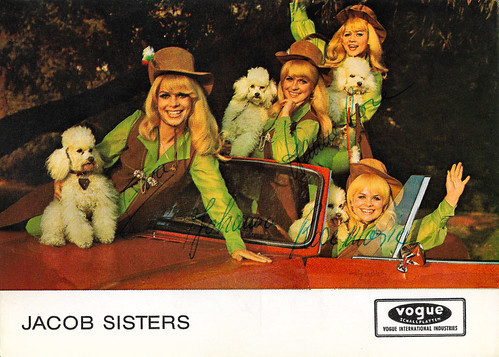
German autograph card by Vogue Schallplatten, no. DV 11122.
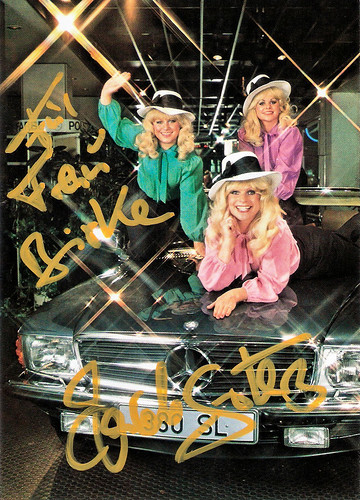
German autograph card by Jacob Sisters, Dreiech. Pictured are Johanna, Rosemarie and Hannelore.
Geschwister Jacob sing 'Auf dem Wege nach Aschaffenburg'. Source: The Lost Beads (YouTube).
Jacob Sisters and their Hampster Dance. Source: salvailshrine (YouTube).
Sources: Ulrich Eichblatt (Die Jacob Sisters - German), Wikipedia (German) and .

German promotion card, no. 5/60. Photo: CBS.

Dutch postcard by Muziek Parade, Hilversum, no. AX 6254.

German autograph card by M-Rekord. Pictured are Johanna, Rosemarie and Hannelore.

German autograph card by Zyx Music.
White Poodles
The Jacob Sisters (in German: geschwister Jacob) come from the Saxon Schmannewitz (municipality Dahlen).
Already in childhood they started their common career as the 'Schmannewitzer Heidelerchen' in the Café Jacob in Schmannewitz. Later, they appeared in and around Leipzig. They attended the Musikhochschule Weimar (Weimar Music Academy), moved to the Federal Republic in 1958 and continued their studies in Frankfurt am Main.
Lia Wöhr gave them an appearance on the television program Zum Blauen Bock. In 1963 they had their greatest success in Germany with the 'Gartenzwerg-Marsch' (Garden gnome march), a cover version of a song of British singer Billy Sanders. At that time they still called themselves the Geschwister Jacob.
In 1966 they took part in the German Schlager Festival. Their song 'So ist ein Boy' came in at the eights place. Their biggest international successes have been appearances in Las Vegas and New York in the 1960s. There they performed with Louis Armstrong , Sammy Davis Jr. and Duke Ellington. From then on, they called themselves Jacob Sisters.
Since 1960, they are accompanied during their performances by white poodles that have become their trademark. Their hits included 'Träume der Liebe' (1964), 'Am blauen See im grünen Tal' (1965), 'Gartenzwerg-Marsch' (1965), 'Was hab`ich Dir getan' (1965) and 'Auf dem Wege nach Aschaffenburg' (1969).
During the 1960s, they also performed in several films, such as Dr. Murkes gesammelte Nachrufe/Dr. Murkes collected obituaries (Rolf Hädrich, 1965) with Dieter Hildebrandt and Dieter Borsche , and the comedy Quartett im Bett/Quartet in Bed (Ulrich Schamoni, 1968). For their performances in the latter film they won the Ernst Lubitsch Preis.

Dutch postcard by Gebr. Spanjersberg N.V., Rotterdam (SPARO), no. 1245. The Jacob Sisters at Schiphol during their visit to the Netherlands in 1965.

Dutch postcard by Hercules, Haarlem, no. 1350 A. Photo: CBS. The Geschwister Jacob during a visit of miniature town Madurodam in Den Haag (The Haghe), The Netherlands.

Dutch postcard by N.V. v.h. Weenenk & Snel, Baarn. Sent by mail in 1966. Photo: CBS. The Jacob Sisters during a visit of miniature town Madurodam in The Haghe.

German promotion card by CBS.
I am a star - get me out of here!
Through the years, the Jacob Sisters became a hilarious cult phenomenon. Their songs included parodies on hits like 'Sonderzug nach Pankow', 'Pariser Tango' and 'Yes Sir, I Can Boogie'. At the end of the 1990s and the beginning of the 2000s, the Jacob Sisters appeared several times as star guests at the Madame Lothár Theater in Bremen, where they also took part in a gala show in June 2002 on the occasion of the tenth anniversary of the theatre.
They often appeared on German television and radio, especially in folk music programs such as in the TV series Feste der Volksmusik, Lieder sind die besten Freunde (Songs are the best friends) and Musikantenstadl, but also in many other shows. They also persormed in the TV series Ein Heim für Tiere/The Adventures of Dr. Bayer (1987) and the Krimi series Die Kommissarin/Lady Cop (1995), featuring Hannelore Elsner .
With the Techno song 'The Hampster Dance' (2001), the four sisters even reached the top of the Canadian charts. They also appeared in the film comedy Ausziehn!/Undress! (Peter Morlock, 2001) with Désirée Nick and Evelyn Künneke , and in the TV series Polly Adler (2008).
In 2008 Hannelore Jacob died of heart failure as a result of pneumonia. In 2011 Eva Jacob participated in the 5th season of the RTL show Ich bin ein Star – Holt mich hier raus! (I am a star - get me out of here!).
Johanna Jacob died on in 2015 in Sana Klinikum Offenbach from the effects of a stroke. She was buried next to her sister Hannelore on the forest cemetery Buchenbusch. The remaining Jacob sisters, Eva and Rosi are still going strong.

German promotion card by Becker autoradio. Caption: With a Becker autoradio, you can also listen perfectly in your car to the Jacob Sisters.

German promotion card by M-Records (Music Records), München. Photo: M-Records.

German autograph card by Vogue Schallplatten, no. DV 11122.

German autograph card by Jacob Sisters, Dreiech. Pictured are Johanna, Rosemarie and Hannelore.
Geschwister Jacob sing 'Auf dem Wege nach Aschaffenburg'. Source: The Lost Beads (YouTube).
Jacob Sisters and their Hampster Dance. Source: salvailshrine (YouTube).
Sources: Ulrich Eichblatt (Die Jacob Sisters - German), Wikipedia (German) and .
Published on August 11, 2019 22:00
August 10, 2019
Mary Philbin
Mary Philbin (1902-1993) was an American film actress of the silent film era. She is best known for her roles in two silent horror classics: soprano Christine Daaé in The Phantom of the Opera (1925) opposite Lon Chaney, and the blind Dea in The Man Who Laughs (1928), featuring Conrad Veidt.
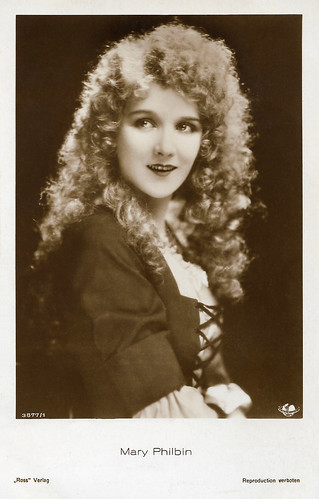
German postcard by Ross Verlag, no. 3877/1, 1928-1929. Photo: Deutsche Universal. Mary Philbin as Christine Daaé in The Phantom of The Opera (Rupert Julian, 1925).
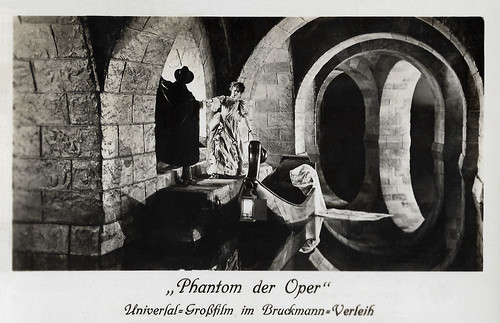
German postcard by Bruckmann-Verleih. Photo: Universal. Lon Chaney and Mary Philbin in The Phantom of the Opera (Rupert Julian, 1925). Caption: "Premiere at the Primus Palast 5 November 1925."

German postcard by Ross Verlag, no. 105/1. Photo: Universal Pictures Corp. Conrad Veidt and Mary Philbin in The Man Who Laughs (Paul Leni, 1928).
An angelic, sweet, quiet, young lady
Mary Philbin was born in 1903, in Chicago, Illinois, to John Philbin and his first wife and namesake, Mary. The child was regarded as a little beauty from an early age and her mother was exceedingly proud of her and loved to show her off. Her mother was controlling and domineering, to the point of imprinting her strict religious beliefs on the child. Mary took after her shy, quiet and reserved father, whom she adored.
Emily Greene at IMDb : "Many of her contemporaries remarked how she didn't seem to belong to the current age; her personality was a throwback to the 19th century with her mannerisms and religious, quiet and very gentle nature. Being an only child, Mary grew up quite spoiled by her mother. Her father would take her often to see the plays at local theaters and even, on rare occasion, to see an opera at the Chicago Opera House."
She fell in love with the stage and decided that she wanted a career in the theatre. She took up classical dancing (ballet and waltz) and was quite adept at playing the pipe organ and piano, although much to her chagrin, she could not sing. However, she did not train in an acting school and this would ultimately impact on her later career.
Her best friend was Carla Laemmle, the daughter of Joseph Laemmle, brother of Universal Studios mogul Carl Laemmle. Through her friend's uncle, Mary became interested in films and put her stage career on hold. Upon seeing her first "Nickelodeon", she was bitten by the film bug and eagerly awaited any new ones that came out.
She was particularly fond of the films of Erich von Stroheim, so much so that at the age of 16, when she heard that the director was making his new film Blind Husbands (1919) and a contest was set up to search for talent for the film, Mary tried to sign up. At first she could not find the right photograph worthy of submission, but her mother had taken a picture and submitted it. The contest was held in Chicago at the Elks Club and was sponsored by her church, with Von Stroheim himself as the judge. The Teutonic director was smitten with her beauty and her eagerness to behave and speak well, and gave her the leading role in one of his films.
When finding out she was to move to Los Angeles to make the film, Mary at first had reservations and consulted her parents. Her parents refused until they found out their old family friends, the Laemmles, were moving out to Los Angeles as well, and they gave consent for Mary to go but only with her parents as her chaperons due to their fear that the 'sheiks' of Los Angeles would corrupt Mary's moral character.
When arriving at the studio, she found out that she had been replaced in the leading role in Blind Husbands. Mary was deeply hurt at the time and felt cheated, and was considering going home had it not been for her friend Carla who recommended her to her uncle, the owner of Universal City, Carl Laemmle, and the man in charge of production, Irving Thalberg. Although Carl Laemmle had met Mary some time earlier and always regarded her as an 'angelic, sweet, quiet' young lady, he was none too impressed with her at the time to consider her for a contract, owing mostly to her moralistic and reserved disposition. Thalberg held the same reservations about her.
However, after being persuaded by Mary's family and Carla, Carl caved and gave 17-year-old Mary her first big part: Talitby Millicuddy, the leading lady, in the melodrama The Blazing Trail (Robert Thornby, 1921) starring Frank Mayo. Mary caught on in films very quickly and was considered by the public, initially at least, in the same league as her bigger contemporaries - Mary Pickford , Florence Lawrence, Mae Marsh and Lillian Gish , one of those 'child-woman' actresses particularly noted for her subtle but extraordinary ethereal Irish beauty.
In 1922, Philbin was awarded at the first annual WAMPAS Baby Stars awards, a promotional campaign sponsored by the Western Association of Motion Picture Advertisers, which honoured thirteen young women each year whom they believed to be on the threshold of movie stardom.
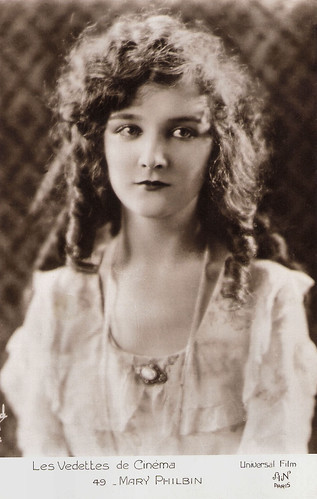
French postcard in the Les Vedettes de Cinéma series by A.N., Paris, no. 49. Photo: Universal Film.
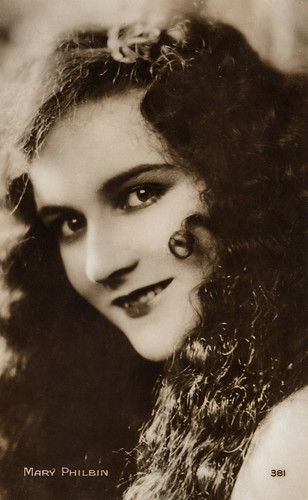
French postcard by Editions Cinémagazine, no. 381.
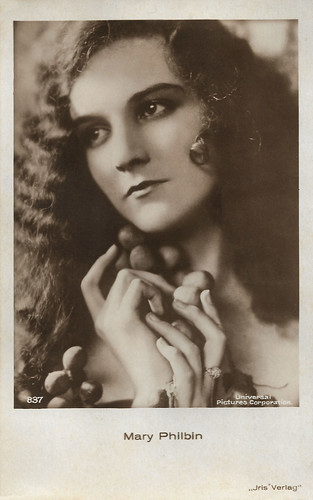
Austrian postcard by Iris-Verlag, no. 837. Photo: Universal Pictures Corporation.
The wildly extravagant Erich von Stroheim
After the moderate success of her first film, Mary Philbin was cast in Danger Ahead! (Rollin S. Sturgeon, 1921), the one-reel comedy Twelve Hours to Live (William Watson, 1921), and the Western Red Courage (B. Reeves Eason, 1921), starring Hoot Gibson. In all, she made six films in 1921.
After seeing her work in Danger Ahead, Erich von Stroheim cast Mary in a small part as the crippled girl for his next film, Foolish Wives (Erich von Stroheim, 1922). It would become the most expensive production ever for Univeral; the costs rising up to a million dollars. Mary can be seen in the film as the little girl on crutches with her back turned, and you only quickly get a darkened glimpse of her face through her curly ringlets. Although her role in the film was just a bit part, Mary relished being under Von Stroheim's tutelage and it was from him, as she always said, she learned about 'true' acting in comparison to stage acting.
Emily Greene at IMDb : "It has always been said of Mary Philbin that when the director was really good (such as von Stroheim, Paul Leni and William Beaudine), people noticed she could be equally as good an actress as her colleagues. However, in the hands less talented directors such as Rupert Julian, who would partly direct her later in Merry-Go-Round (1923) and The Phantom of the Opera, her lack of acting training became a real handicap for her (this is clearly evident in some of her later films)."
Mary began to get more notice from Carl Laemmle and Irving Thalberg, after Erich von Stroheim 's high recommendation of her. After a minor film, The Trouper (Harry B. Harris, 1922) starring Gladys Walton, she was given the role of Ruth in Human Hearts (King Baggot, 1922). Mary began to get even further recognition, but her personal life was darkened by her father's divorce and remarriage to Alice Mead. Mary was shattered by the event, and as a result became closer to her mother.
Mary made two more films before she received her first big break as the heroine Agnes Urban, in von Stroheim's The Merry-Go-Round (1923). The casting for this film, set in the Austro-Hungarian Empire of the time of Emperor Franz Josef, was impeccable and in particular with her leading man, Norman Kerry, she would be reunited in several films. The production came to a standstill when the perfectionist von Stroheim insisted that some of the actors wear underwear embroidered with the Imperial Austrian Royal Family insignia, which infuriated Carl Laemmle. After an intense argument with Laemmle the wildly extravagant director was dropped from the picture.
The cast was stunned and the two most affected were Wallace Beery (cast as Agnes' father) and Mary Philbin. Beery, infuriated with Laemmle's decision walked out, as did many others. Laemmle hired Universal actor Rupert Julian to direct. Not having met or worked with Julian before, Philbin decided to stay, and Cesare Gravina was re-cast in Beery's role. However, it became clearly evident that Julian was a novice compared to von Stroheim, and much of the original footage was cut or re-filmed upon its release. However, Merry-Go-Round (Rupert Julian, Erich von Stroheim, 1923) launched Mary as an official Hollywood star.
During this time, Mary met the love of her life, Universal Studio executive/producer Paul Kohner - through the Laemmles. Paul Kohner was only a year older than Mary and born in Teplitz-Schoenau, Austria-Hungary (now Teplice, Czech Republic). They were immediately smitten with each other - but due to Mary's parents' religion (Roman Catholicism) and the fact that Paul was a Jew - they kept their relationship, in the early years, secret as much as possible.
Mary's film career took off with such films as the comic Western Where Is This West? (George Marshall, 1923), the drama The Age of Desire (Frank Borzage, 1923), the fantasy The Temple of Venus (Henry Otto, 1923), and the action comedy The Thrill Chaser (Edward Sedgwick, 1923) with Hoot Gibson. Paul Kohner sometimes was the producer, which afforded her more time to be with him, under the protection from her parents observance. But it wasn't until 1924, after she made good in the role of Marianne in The Rose of Paris (Irving Cummings, 1924) that Mary was to be cast in her next, most famous and best-remembered film role of her entire career.
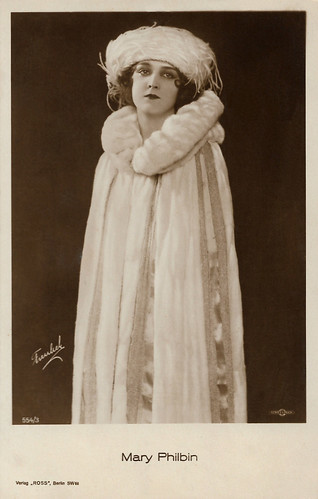
German postcard by Ross Verlag, no. 554/3, 1919-1924. Photo: Roman Freulich/ Unfilman.
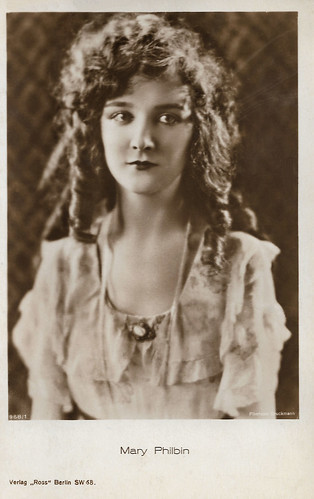
German postcard by Ross Verlag, no. 968/1, 1925-1926. Photo: Roman Freulich / Filmhaus Bruckmann.
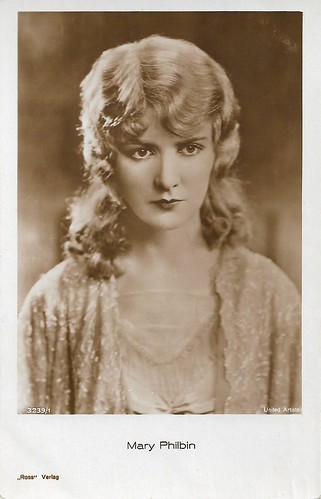
German postcard by Ross Verlag, no. 3239/1, 1928-1929. Photo: United Artists.
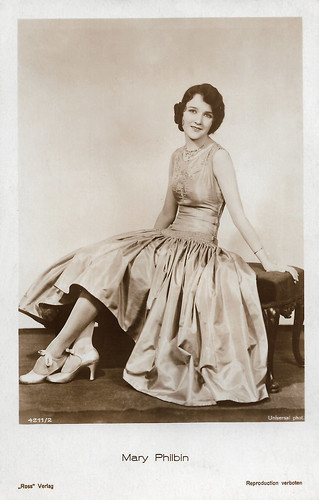
German postcard by Ross Verlag, no. 4211/2, 1929-1930. Photo: Universal.
Universal's biggest money maker of the decade
In 1924, Carl Laemmle was searching among the elite list of Hollywood starlets for the role of the young Swedish soprano Christine Daaé in the film adaption of Gaston Leroux's novella 'Le Fantôme de l'Opéra' (The Phantom of the Opera) starring in the leading role of Erik, the Phantom of the Opera, was one of Hollywood's best actors Lon Chaney , fresh from his success in The Hunchback of Notre Dame (Wallace Worsley, 1923). Much to the concern of the cast and crew, the director hired for the picture was the temperamental Rupert Julian. Julian remembered Mary and Norman Kerry from Merry-Go-Round and hired them.
Mary was cast in the key role of Christine, the chance of a lifetime. But the production was one of the most difficult for the cast to endure. Although Mary was working alongside of many of her former colleagues and friends (Norman Kerry, Cesare Gravina, and Carla Laemmle), she had never met Lon Chaney personally before and, in keeping with her nature, was initially very shy and nervous around him.
During the filming Chaney and Julian exchanged heated arguments. Chaney would direct his own scenes including several scenes with Mary. Her big test with Chaney came for the climactic unmasking scene - there was a shot of Mary on the floor screaming after Christine unmasks the Phantom and is supposed to cry. Julian had gone through several takes of the scene with Mary, but all takes failed to satisfy Julian. This angered the cast and crew and Julian called it a day and they shut down early. But Lon Chaney remained behind and asked Mary and the crew to stay and reshoot the scene themselves. His approach was a success. From then on Chaney would always be on the set when Julian was directing Mary in future scenes, even if he was not in it.
The Phantom of the Opera (1925) was Universal's biggest money maker of the decade, launching not only Chaney to stardom but Philbin as well. Her next big role was the dual part of Stella Maris/Unity Blake in a remake of Mary Pickford 's Stella Maris (Marshall Neilan, 1918). The new version, Stella Maris (Charles Brabin, 1925), was received with moderate success with Mary being complimented on her ability to change from the beautiful Stella into the hideous outcast Unity Blake so well that many didn't recognise her.
When Mary was filming The Man who Laughs in the role of the blind girl Dea, her secret fiance Paul Kohner was acting as production supervisor and interpreter for Conrad Veidt who played Gwynplaine. On opening night, the film was hailed as a box-office success and Mary was praised for her the role as Dea. It was then that Mary announced her engagement to Paul Kohner. But her family was outraged at the news and called a meeting to meet Kohner. Paul admitted then he was a staunch Jew and Mary's mother would have none of it. In the end, Mary gave the devastated Paul back the ring. Mary also was devastated, even so much that she would never marry.
At the dawn of talkies, Mary's film career nose-dived along with her personal life. Because of the inadequacy of early recording equipment - Mary's voice recorded as high pitched and squeaky. However, she did dubbed her own voice when The Phantom of the Opera was given sound and re-released in 1929. New scenes with Norman Kerry were intercut with footage of the 1924 version with Chaney.
In retrospect, all of her post-Phantom films were mediocre. She received good notices in D.W. Griffith's otherwise pathetic Drums of Love (1928), co-starring Lionel Barrymore and Don Alvarado. Her final film was the sound film After the Fog (Leander De Cordova, 1929). Mary decided to abandon her film career and took up a life of self-enforced celibacy, becoming a virtual recluse in her father's home. Mary virtually vanished off the face of the earth and Hollywood forgot her.
In the 1960s, it was discovered that Philbin was still alive, living in the very same home in Huntington Beach, she had bought in the 1920s. She had never married and had spent much of her life looking after her parents. It was remarked at how youthful and beautiful she still looked even though she was in her 60s and how her voice still had that youthful girlish quality. She had been a faithful member of her parents' church and only went out to visit friends and family, shop, and go to church. During that time, she admitted that she refused interviews and photo shoots, although she replied to her fans and sent them autographs.
In the late 1970s, Philbin experienced the first symptoms of Alzheimer's Disease. In 1988, Mary made her first public appearance since 1931 at a memorial service for Rudolph Valentino . Another blow came when it was announced Paul Kohner had passed away. Shortly after his death, workers cleaning out his office at his agency found Mary's love letters close at hand in his desk, more than 60 years later. When she was informed, Mary cried and revealed the letters Paul had sent to her and even a few after the 'family incident'.
After that Mary's memory lapses grew worse, and her old friend Carla Laemmle came to help her. At her insistence - Mary made two more public appearances - the first at the Los Angeles opening night of Andrew Lloyd Webber's musical 'The Phantom of the Opera'. And the second to help promote author Philip Riley's study 'The Phantom of the Opera'. After that, Mary was never seen in public again. In 1993, Mary Philbin died of complications from pneumonia. The original Christine Daaé was dead at age 91.
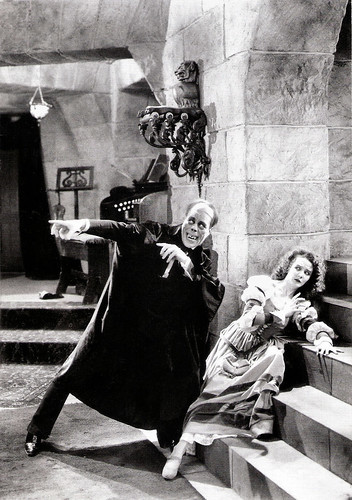
Italian programme card for Il Cinema Ritrovata 2011. Photo: Lon Chaney and Mary Philbin in Phantom of the Opera (Rupert Julian, 1925).
Sources: (IMDb) Wikipedia and .

German postcard by Ross Verlag, no. 3877/1, 1928-1929. Photo: Deutsche Universal. Mary Philbin as Christine Daaé in The Phantom of The Opera (Rupert Julian, 1925).

German postcard by Bruckmann-Verleih. Photo: Universal. Lon Chaney and Mary Philbin in The Phantom of the Opera (Rupert Julian, 1925). Caption: "Premiere at the Primus Palast 5 November 1925."

German postcard by Ross Verlag, no. 105/1. Photo: Universal Pictures Corp. Conrad Veidt and Mary Philbin in The Man Who Laughs (Paul Leni, 1928).
An angelic, sweet, quiet, young lady
Mary Philbin was born in 1903, in Chicago, Illinois, to John Philbin and his first wife and namesake, Mary. The child was regarded as a little beauty from an early age and her mother was exceedingly proud of her and loved to show her off. Her mother was controlling and domineering, to the point of imprinting her strict religious beliefs on the child. Mary took after her shy, quiet and reserved father, whom she adored.
Emily Greene at IMDb : "Many of her contemporaries remarked how she didn't seem to belong to the current age; her personality was a throwback to the 19th century with her mannerisms and religious, quiet and very gentle nature. Being an only child, Mary grew up quite spoiled by her mother. Her father would take her often to see the plays at local theaters and even, on rare occasion, to see an opera at the Chicago Opera House."
She fell in love with the stage and decided that she wanted a career in the theatre. She took up classical dancing (ballet and waltz) and was quite adept at playing the pipe organ and piano, although much to her chagrin, she could not sing. However, she did not train in an acting school and this would ultimately impact on her later career.
Her best friend was Carla Laemmle, the daughter of Joseph Laemmle, brother of Universal Studios mogul Carl Laemmle. Through her friend's uncle, Mary became interested in films and put her stage career on hold. Upon seeing her first "Nickelodeon", she was bitten by the film bug and eagerly awaited any new ones that came out.
She was particularly fond of the films of Erich von Stroheim, so much so that at the age of 16, when she heard that the director was making his new film Blind Husbands (1919) and a contest was set up to search for talent for the film, Mary tried to sign up. At first she could not find the right photograph worthy of submission, but her mother had taken a picture and submitted it. The contest was held in Chicago at the Elks Club and was sponsored by her church, with Von Stroheim himself as the judge. The Teutonic director was smitten with her beauty and her eagerness to behave and speak well, and gave her the leading role in one of his films.
When finding out she was to move to Los Angeles to make the film, Mary at first had reservations and consulted her parents. Her parents refused until they found out their old family friends, the Laemmles, were moving out to Los Angeles as well, and they gave consent for Mary to go but only with her parents as her chaperons due to their fear that the 'sheiks' of Los Angeles would corrupt Mary's moral character.
When arriving at the studio, she found out that she had been replaced in the leading role in Blind Husbands. Mary was deeply hurt at the time and felt cheated, and was considering going home had it not been for her friend Carla who recommended her to her uncle, the owner of Universal City, Carl Laemmle, and the man in charge of production, Irving Thalberg. Although Carl Laemmle had met Mary some time earlier and always regarded her as an 'angelic, sweet, quiet' young lady, he was none too impressed with her at the time to consider her for a contract, owing mostly to her moralistic and reserved disposition. Thalberg held the same reservations about her.
However, after being persuaded by Mary's family and Carla, Carl caved and gave 17-year-old Mary her first big part: Talitby Millicuddy, the leading lady, in the melodrama The Blazing Trail (Robert Thornby, 1921) starring Frank Mayo. Mary caught on in films very quickly and was considered by the public, initially at least, in the same league as her bigger contemporaries - Mary Pickford , Florence Lawrence, Mae Marsh and Lillian Gish , one of those 'child-woman' actresses particularly noted for her subtle but extraordinary ethereal Irish beauty.
In 1922, Philbin was awarded at the first annual WAMPAS Baby Stars awards, a promotional campaign sponsored by the Western Association of Motion Picture Advertisers, which honoured thirteen young women each year whom they believed to be on the threshold of movie stardom.

French postcard in the Les Vedettes de Cinéma series by A.N., Paris, no. 49. Photo: Universal Film.

French postcard by Editions Cinémagazine, no. 381.

Austrian postcard by Iris-Verlag, no. 837. Photo: Universal Pictures Corporation.
The wildly extravagant Erich von Stroheim
After the moderate success of her first film, Mary Philbin was cast in Danger Ahead! (Rollin S. Sturgeon, 1921), the one-reel comedy Twelve Hours to Live (William Watson, 1921), and the Western Red Courage (B. Reeves Eason, 1921), starring Hoot Gibson. In all, she made six films in 1921.
After seeing her work in Danger Ahead, Erich von Stroheim cast Mary in a small part as the crippled girl for his next film, Foolish Wives (Erich von Stroheim, 1922). It would become the most expensive production ever for Univeral; the costs rising up to a million dollars. Mary can be seen in the film as the little girl on crutches with her back turned, and you only quickly get a darkened glimpse of her face through her curly ringlets. Although her role in the film was just a bit part, Mary relished being under Von Stroheim's tutelage and it was from him, as she always said, she learned about 'true' acting in comparison to stage acting.
Emily Greene at IMDb : "It has always been said of Mary Philbin that when the director was really good (such as von Stroheim, Paul Leni and William Beaudine), people noticed she could be equally as good an actress as her colleagues. However, in the hands less talented directors such as Rupert Julian, who would partly direct her later in Merry-Go-Round (1923) and The Phantom of the Opera, her lack of acting training became a real handicap for her (this is clearly evident in some of her later films)."
Mary began to get more notice from Carl Laemmle and Irving Thalberg, after Erich von Stroheim 's high recommendation of her. After a minor film, The Trouper (Harry B. Harris, 1922) starring Gladys Walton, she was given the role of Ruth in Human Hearts (King Baggot, 1922). Mary began to get even further recognition, but her personal life was darkened by her father's divorce and remarriage to Alice Mead. Mary was shattered by the event, and as a result became closer to her mother.
Mary made two more films before she received her first big break as the heroine Agnes Urban, in von Stroheim's The Merry-Go-Round (1923). The casting for this film, set in the Austro-Hungarian Empire of the time of Emperor Franz Josef, was impeccable and in particular with her leading man, Norman Kerry, she would be reunited in several films. The production came to a standstill when the perfectionist von Stroheim insisted that some of the actors wear underwear embroidered with the Imperial Austrian Royal Family insignia, which infuriated Carl Laemmle. After an intense argument with Laemmle the wildly extravagant director was dropped from the picture.
The cast was stunned and the two most affected were Wallace Beery (cast as Agnes' father) and Mary Philbin. Beery, infuriated with Laemmle's decision walked out, as did many others. Laemmle hired Universal actor Rupert Julian to direct. Not having met or worked with Julian before, Philbin decided to stay, and Cesare Gravina was re-cast in Beery's role. However, it became clearly evident that Julian was a novice compared to von Stroheim, and much of the original footage was cut or re-filmed upon its release. However, Merry-Go-Round (Rupert Julian, Erich von Stroheim, 1923) launched Mary as an official Hollywood star.
During this time, Mary met the love of her life, Universal Studio executive/producer Paul Kohner - through the Laemmles. Paul Kohner was only a year older than Mary and born in Teplitz-Schoenau, Austria-Hungary (now Teplice, Czech Republic). They were immediately smitten with each other - but due to Mary's parents' religion (Roman Catholicism) and the fact that Paul was a Jew - they kept their relationship, in the early years, secret as much as possible.
Mary's film career took off with such films as the comic Western Where Is This West? (George Marshall, 1923), the drama The Age of Desire (Frank Borzage, 1923), the fantasy The Temple of Venus (Henry Otto, 1923), and the action comedy The Thrill Chaser (Edward Sedgwick, 1923) with Hoot Gibson. Paul Kohner sometimes was the producer, which afforded her more time to be with him, under the protection from her parents observance. But it wasn't until 1924, after she made good in the role of Marianne in The Rose of Paris (Irving Cummings, 1924) that Mary was to be cast in her next, most famous and best-remembered film role of her entire career.

German postcard by Ross Verlag, no. 554/3, 1919-1924. Photo: Roman Freulich/ Unfilman.

German postcard by Ross Verlag, no. 968/1, 1925-1926. Photo: Roman Freulich / Filmhaus Bruckmann.

German postcard by Ross Verlag, no. 3239/1, 1928-1929. Photo: United Artists.

German postcard by Ross Verlag, no. 4211/2, 1929-1930. Photo: Universal.
Universal's biggest money maker of the decade
In 1924, Carl Laemmle was searching among the elite list of Hollywood starlets for the role of the young Swedish soprano Christine Daaé in the film adaption of Gaston Leroux's novella 'Le Fantôme de l'Opéra' (The Phantom of the Opera) starring in the leading role of Erik, the Phantom of the Opera, was one of Hollywood's best actors Lon Chaney , fresh from his success in The Hunchback of Notre Dame (Wallace Worsley, 1923). Much to the concern of the cast and crew, the director hired for the picture was the temperamental Rupert Julian. Julian remembered Mary and Norman Kerry from Merry-Go-Round and hired them.
Mary was cast in the key role of Christine, the chance of a lifetime. But the production was one of the most difficult for the cast to endure. Although Mary was working alongside of many of her former colleagues and friends (Norman Kerry, Cesare Gravina, and Carla Laemmle), she had never met Lon Chaney personally before and, in keeping with her nature, was initially very shy and nervous around him.
During the filming Chaney and Julian exchanged heated arguments. Chaney would direct his own scenes including several scenes with Mary. Her big test with Chaney came for the climactic unmasking scene - there was a shot of Mary on the floor screaming after Christine unmasks the Phantom and is supposed to cry. Julian had gone through several takes of the scene with Mary, but all takes failed to satisfy Julian. This angered the cast and crew and Julian called it a day and they shut down early. But Lon Chaney remained behind and asked Mary and the crew to stay and reshoot the scene themselves. His approach was a success. From then on Chaney would always be on the set when Julian was directing Mary in future scenes, even if he was not in it.
The Phantom of the Opera (1925) was Universal's biggest money maker of the decade, launching not only Chaney to stardom but Philbin as well. Her next big role was the dual part of Stella Maris/Unity Blake in a remake of Mary Pickford 's Stella Maris (Marshall Neilan, 1918). The new version, Stella Maris (Charles Brabin, 1925), was received with moderate success with Mary being complimented on her ability to change from the beautiful Stella into the hideous outcast Unity Blake so well that many didn't recognise her.
When Mary was filming The Man who Laughs in the role of the blind girl Dea, her secret fiance Paul Kohner was acting as production supervisor and interpreter for Conrad Veidt who played Gwynplaine. On opening night, the film was hailed as a box-office success and Mary was praised for her the role as Dea. It was then that Mary announced her engagement to Paul Kohner. But her family was outraged at the news and called a meeting to meet Kohner. Paul admitted then he was a staunch Jew and Mary's mother would have none of it. In the end, Mary gave the devastated Paul back the ring. Mary also was devastated, even so much that she would never marry.
At the dawn of talkies, Mary's film career nose-dived along with her personal life. Because of the inadequacy of early recording equipment - Mary's voice recorded as high pitched and squeaky. However, she did dubbed her own voice when The Phantom of the Opera was given sound and re-released in 1929. New scenes with Norman Kerry were intercut with footage of the 1924 version with Chaney.
In retrospect, all of her post-Phantom films were mediocre. She received good notices in D.W. Griffith's otherwise pathetic Drums of Love (1928), co-starring Lionel Barrymore and Don Alvarado. Her final film was the sound film After the Fog (Leander De Cordova, 1929). Mary decided to abandon her film career and took up a life of self-enforced celibacy, becoming a virtual recluse in her father's home. Mary virtually vanished off the face of the earth and Hollywood forgot her.
In the 1960s, it was discovered that Philbin was still alive, living in the very same home in Huntington Beach, she had bought in the 1920s. She had never married and had spent much of her life looking after her parents. It was remarked at how youthful and beautiful she still looked even though she was in her 60s and how her voice still had that youthful girlish quality. She had been a faithful member of her parents' church and only went out to visit friends and family, shop, and go to church. During that time, she admitted that she refused interviews and photo shoots, although she replied to her fans and sent them autographs.
In the late 1970s, Philbin experienced the first symptoms of Alzheimer's Disease. In 1988, Mary made her first public appearance since 1931 at a memorial service for Rudolph Valentino . Another blow came when it was announced Paul Kohner had passed away. Shortly after his death, workers cleaning out his office at his agency found Mary's love letters close at hand in his desk, more than 60 years later. When she was informed, Mary cried and revealed the letters Paul had sent to her and even a few after the 'family incident'.
After that Mary's memory lapses grew worse, and her old friend Carla Laemmle came to help her. At her insistence - Mary made two more public appearances - the first at the Los Angeles opening night of Andrew Lloyd Webber's musical 'The Phantom of the Opera'. And the second to help promote author Philip Riley's study 'The Phantom of the Opera'. After that, Mary was never seen in public again. In 1993, Mary Philbin died of complications from pneumonia. The original Christine Daaé was dead at age 91.

Italian programme card for Il Cinema Ritrovata 2011. Photo: Lon Chaney and Mary Philbin in Phantom of the Opera (Rupert Julian, 1925).
Sources: (IMDb) Wikipedia and .
Published on August 10, 2019 22:00
August 9, 2019
10 Czech collectors cards of Marcello Mastroianni
A few months ago, EFSP had a post on Claudia Cardinale with a series of Czech collectors cards, which I recently had acquired. I then also found another set of Czech collectors cards published by Pressfoto. The subject was Italy's most famous male film star, Marcello Mastroianni. The small cards date from the same year, 1965, and show Mastroianni in private situations and in some of his classic films of the early 1960s.
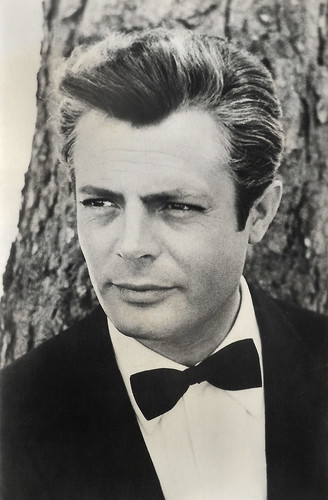
Marcello Mastroianni in La notte (Michelangelo Antonioni, 1961). Small Czechoslovakian card by Pressfoto, Praha (Prague), no. S 83/1, 1965. Retail price: 0,50 Kcs.
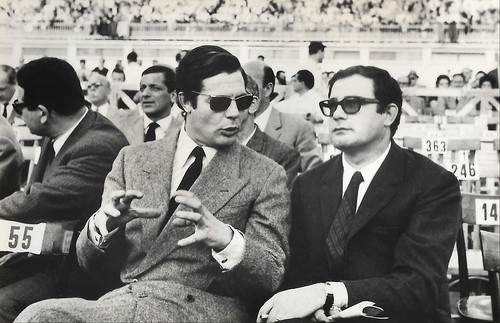
Small Czechoslovakian card by Pressfoto, Praha (Prague), S 83/2, 1965. Retail price: 0,50 Kcs.
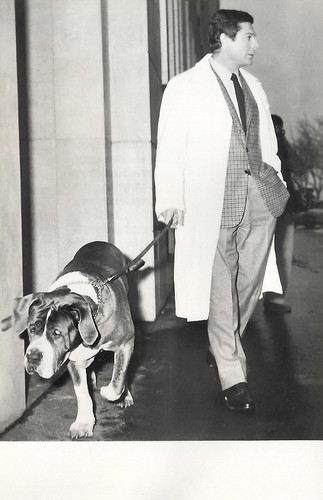
Small Czechoslovakian card by Pressfoto, Praha (Prague), no. S 83/3, 1965. Retail price: 0,50 Kcs.
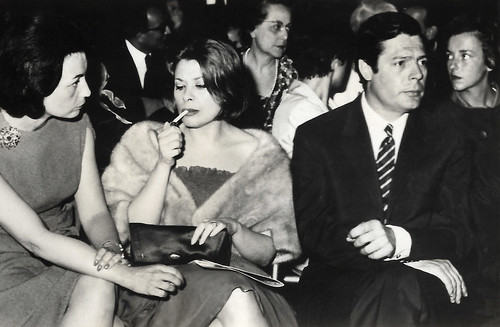
Small Czechoslovakian card by Pressfoto, Praha (Prague), no. S 83/4, 1965. Retail price: 0,50 Kcs.
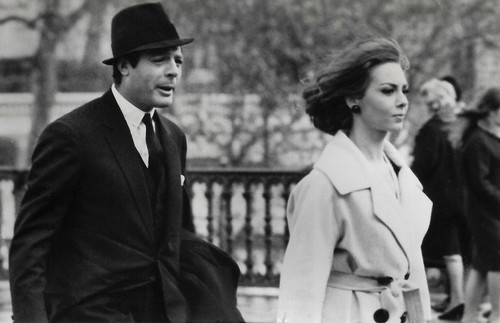
Marcello Mastroianni and Michèle Mercier in Casanova '70 (Mario Monicelli, 1965). Small Czechoslovakian card by Pressfoto, Praha (Prague), no. S 83/5, 1965. Retail price: 0,50 Kcs.
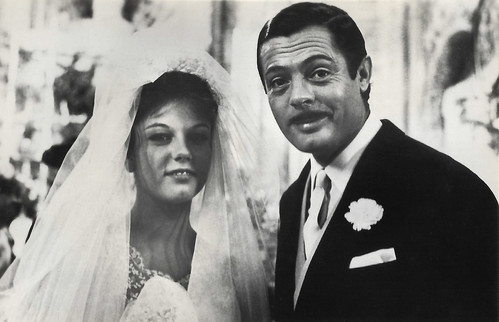
Stefania Sandrelli and Marcello Mastroianni in Divorzio all'italiana/Divorce, Italian Style (Pietro Germi, 1961). Small Czechoslovakian card by Pressfoto, Praha (Prague), no. S 83/6, 1965. Retail price: 0,50 Kcs.
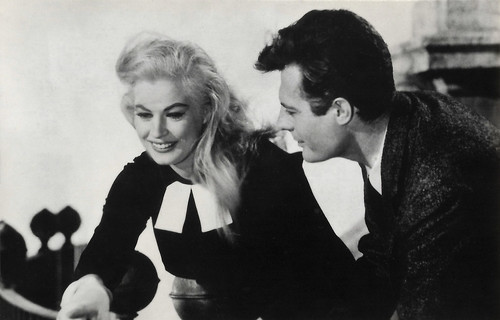
Anita Ekberg and Marcello Mastroianni in La dolce vita (Federico Fellini, 1960). Small Czechoslovakian card by Pressfoto, Praha (Prague), no. S 83/7, 1965. Retail price: 0,50 Kcs.
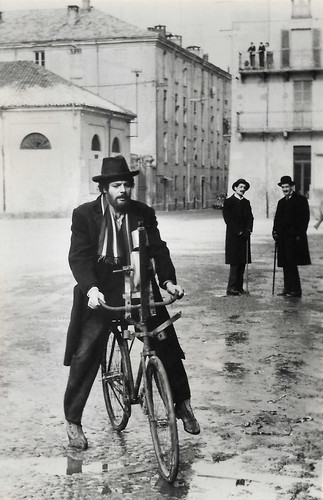
Marcello Mastroianni in I compagni/The Organiser (Mario Monicelli, 1963). Small Czechoslovakian card by Pressfoto, Praha (Prague), no. S 83/8, 1965. Retail price: 0,50 Kcs.
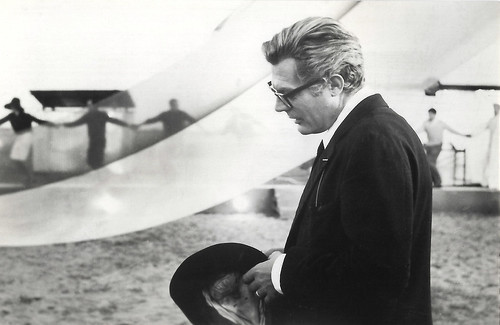
Marcello Mastroianni in 8½ (Federico Fellini, 1963). Small Czechoslovakian card by Pressfoto, Praha (Prague), no. S 83/9, 1965. Retail price: 0,50 Kcs.
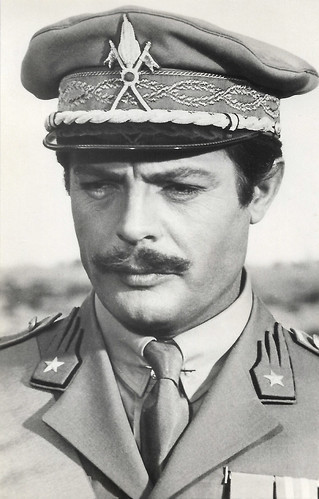
Marcello Mastroianni in Casanova '70 (Mario Monicelli, 1965). Small Czechoslovakian card by Pressfoto, Praha (Prague), no. S 83/10, 1965. Retail price: 0,50 Kcs.

Marcello Mastroianni in La notte (Michelangelo Antonioni, 1961). Small Czechoslovakian card by Pressfoto, Praha (Prague), no. S 83/1, 1965. Retail price: 0,50 Kcs.

Small Czechoslovakian card by Pressfoto, Praha (Prague), S 83/2, 1965. Retail price: 0,50 Kcs.

Small Czechoslovakian card by Pressfoto, Praha (Prague), no. S 83/3, 1965. Retail price: 0,50 Kcs.

Small Czechoslovakian card by Pressfoto, Praha (Prague), no. S 83/4, 1965. Retail price: 0,50 Kcs.

Marcello Mastroianni and Michèle Mercier in Casanova '70 (Mario Monicelli, 1965). Small Czechoslovakian card by Pressfoto, Praha (Prague), no. S 83/5, 1965. Retail price: 0,50 Kcs.

Stefania Sandrelli and Marcello Mastroianni in Divorzio all'italiana/Divorce, Italian Style (Pietro Germi, 1961). Small Czechoslovakian card by Pressfoto, Praha (Prague), no. S 83/6, 1965. Retail price: 0,50 Kcs.

Anita Ekberg and Marcello Mastroianni in La dolce vita (Federico Fellini, 1960). Small Czechoslovakian card by Pressfoto, Praha (Prague), no. S 83/7, 1965. Retail price: 0,50 Kcs.

Marcello Mastroianni in I compagni/The Organiser (Mario Monicelli, 1963). Small Czechoslovakian card by Pressfoto, Praha (Prague), no. S 83/8, 1965. Retail price: 0,50 Kcs.

Marcello Mastroianni in 8½ (Federico Fellini, 1963). Small Czechoslovakian card by Pressfoto, Praha (Prague), no. S 83/9, 1965. Retail price: 0,50 Kcs.

Marcello Mastroianni in Casanova '70 (Mario Monicelli, 1965). Small Czechoslovakian card by Pressfoto, Praha (Prague), no. S 83/10, 1965. Retail price: 0,50 Kcs.
Published on August 09, 2019 22:00
August 8, 2019
George Bancroft
Burly, beefy and tall George Bancroft (1882-1956) was an American film and stage actor who played many ill-tempered tough guys. He received an Oscar nomination for his part as Thunderbolt Jim Lang in Josef von Sternberg's gangster film Thunderbolt (1929). Bancroft is also well remembered as Marshal Curly Wilcox in John Ford's Western Stagecoach (1939).
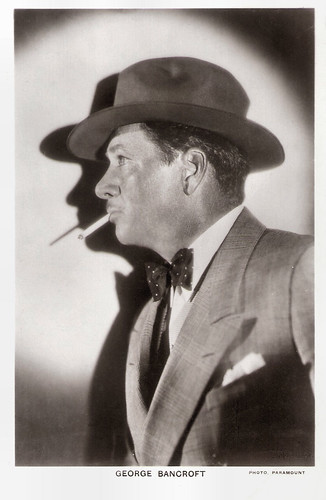
British postcard in the Picturegoer Series, London, no. 432a. Photo: Paramount.
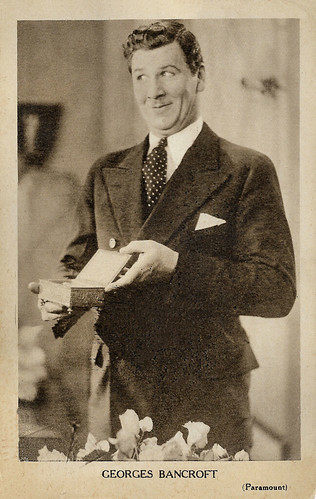
Belgian postcard. Photo: Paramount.
A natural for heavies
George Bancroft was born in 1882 in Philadelphia, Pennsylvania. He attended high school at Tomes Institute in Port Deposit, Maryland.
After working on merchant marine vessels at age 14, Bancroft was an apprentice on the USS Constellation and later served on the USS Essex in the West Indies. Additionally, during the Battle of Manila Bay (1898), he was a gunner on the USS Baltimore. During his days in the Navy, he staged plays aboard ship.
In 1900, he swam underneath the hull of the battleship USS Oregon to check the extent of the damage after it struck a rock off the coast of China. For this, he won an impressive appointment to the United States Naval Academy at Annapolis. He graduated as a commissioned officer, and served in the Navy for the prescribed period of required service but no more.
He decided to turn to show business, first as a theatre manager. In 1901, Bancroft began acting in earnest, as he toured in plays and had juvenile leads in musical comedies. In vaudeville, he did blackface routines and impersonated celebrities. By 1923, he was good enough for Broadway and spent about a year there doing two plays, the musical comedies 'Cinders' (1923) and 'The Rise of Rosie O'Reilly' (1923).
Two years earlier, he had already made his first appearance in the silent film The Journey's End (Hugo Ballin, 1921). Being a big man with dark features, he was a natural for heavies. And it seemed that early Westerns were an easy fit as well after his first four films. Through 1924 and into 1925, he did four, culminating with pay dirt in his appealing performance as rogue Jack Slade in the silent Western The Pony Express (James Cruze, 1925). With him was another up-and-coming character actor, Wallace Beery.
Bancroft's acting made Paramount Pictures take a look at him as star material. He played an important supporting role in a cast including Wallace Beery and Charles Farrell in the period naval widescreen epic Old Ironsides (James Cruze, 1926).
His roles as tough guy took on more flesh in his association with director Josef von Sternberg and his well-honed gangster films. The first of these was Underworld (Josef von Sternberg, 1927) with Clive Brook and Evelyn Brent. Journalist and screenwriter Ben Hecht won an Academy Award for Best Original Story. He next appeared in von Sternberg's The Docks of New York (Josef von Sternberg, 1928) with Betty Compson and Olga Baclanova , and their work culminated with Thunderbolt (Josef von Sternberg, 1929) for which Bancroft received an Oscar nomination. He was tops at the box office.
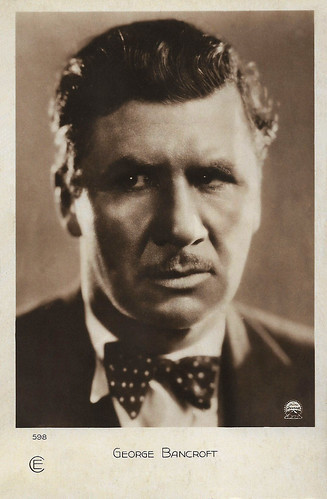
French postcard by Cinémagazine-Edition, Paris, no. 598. Photo: Paramount.
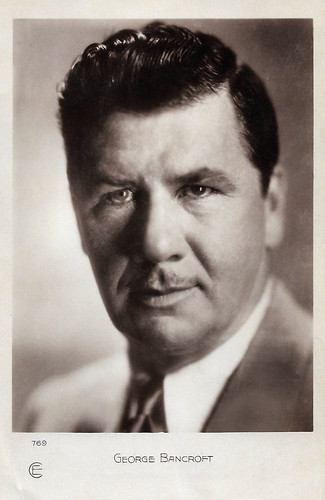
French postcard by Cinémagazine-Edition, Paris, no. 769. Sent by mail in 1931.
One bullet can't kill Bancroft!
George Bancroft played the title role in The Wolf of Wall Street (Rowland V. Lee, 1929), released just prior to the Wall Street Crash. It was Bancroft's first talkie. He appeared in Paramount's all-star revue Paramount on Parade (Elsie Hanis, a.o., 1930) and the crime film Blood Money (Rowland Brown, 1933) with Frances Dee and Judith Anderson.
His various on-screen personas as a bigger-than-life strongman was not far from his off-screen character as Hollywood notability got to him. It was recalled that he became more difficult to deal with as his ego grew. William McPeak at IMDb : "At one point, he refused to obey a director's order that he fall down after being shot by the villain. Bancroft declared, 'One bullet can't kill Bancroft!'"
He stayed busy through the 1930s as older and stouter featured characters. Bancroft was getting competition from younger character actors. In the early 1930s, his roles continued to typecast him as lead heavies, but increasingly, he was cast as second tier in later roles. He was paper editor MacWade in Mr. Deeds Goes to Town (Frank Capra, 1936), starring Gary Cooper and Jean Arthur, a doctor in A Doctor's Diary (Charles Vidor, 1937), a contractor in Angels with Dirty Faces (Michael Curtiz, 1938) with James Cagney and Humphrey Bogart, and a warden in Each Dawn I Die (William Keighley, 1939) with Cagney and George Raft.
Most memorably is his Marshal Curly Wilcox in the classic Western Stagecoach (John Ford, 1939), opposite John Wayne. Here he is particularly engaging as a tough lawman with a big heart.
Into the 1940s, he only did a handful of films. But he again had a rogue's spotlight with another name director, Cecil B. DeMille, in one of his epics. He played a Texas Ranger chasing a murderer over the Canadian border in North West Mounted Police (Cecil B. DeMille, 1940) with a stellar cast including Gary Cooper , Madeleine Carroll , and Paulette Goddard as fleeing criminal, Jacques Corbeau's (Bancroft) daughter.
By 1942, Bancroft had decided to move on, retiring with the intention of becoming a Southern California rancher. He quietly assumed this new role for a long run of 14 years before his death. George Bancroft passed away in 1956 in Santa Monica, California. He was married twice, first to Edna Brothers, and after their divorce to silent film actress Octavia Broske. They had a daughter Georgette.
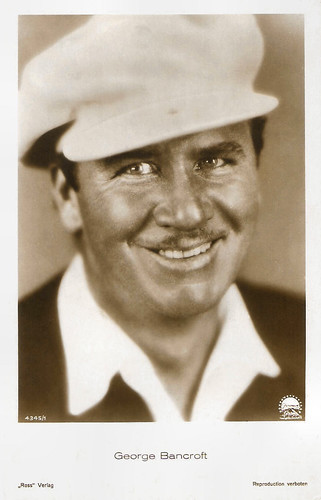
German postcard by Ross Verlag, no. 4345/1, 1929-1930. Photo: Paramount.
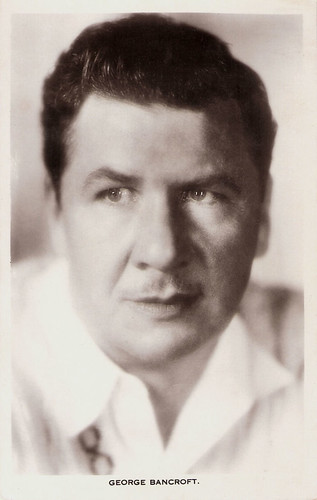
British postcard in the Picturegoer Series, London, no. 432.
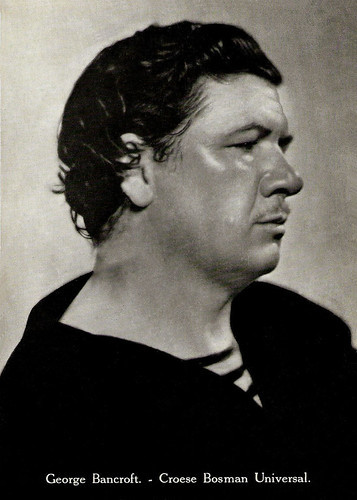
Dutch postcard by Photodruk Smeets & Schippers, Amsterdam. Photo: Croese Bosman / Universal. George Bancroft in The World and the Flesh (John Cromwell, 1932).
Sources: (IMDb), Wikipedia and .

British postcard in the Picturegoer Series, London, no. 432a. Photo: Paramount.

Belgian postcard. Photo: Paramount.
A natural for heavies
George Bancroft was born in 1882 in Philadelphia, Pennsylvania. He attended high school at Tomes Institute in Port Deposit, Maryland.
After working on merchant marine vessels at age 14, Bancroft was an apprentice on the USS Constellation and later served on the USS Essex in the West Indies. Additionally, during the Battle of Manila Bay (1898), he was a gunner on the USS Baltimore. During his days in the Navy, he staged plays aboard ship.
In 1900, he swam underneath the hull of the battleship USS Oregon to check the extent of the damage after it struck a rock off the coast of China. For this, he won an impressive appointment to the United States Naval Academy at Annapolis. He graduated as a commissioned officer, and served in the Navy for the prescribed period of required service but no more.
He decided to turn to show business, first as a theatre manager. In 1901, Bancroft began acting in earnest, as he toured in plays and had juvenile leads in musical comedies. In vaudeville, he did blackface routines and impersonated celebrities. By 1923, he was good enough for Broadway and spent about a year there doing two plays, the musical comedies 'Cinders' (1923) and 'The Rise of Rosie O'Reilly' (1923).
Two years earlier, he had already made his first appearance in the silent film The Journey's End (Hugo Ballin, 1921). Being a big man with dark features, he was a natural for heavies. And it seemed that early Westerns were an easy fit as well after his first four films. Through 1924 and into 1925, he did four, culminating with pay dirt in his appealing performance as rogue Jack Slade in the silent Western The Pony Express (James Cruze, 1925). With him was another up-and-coming character actor, Wallace Beery.
Bancroft's acting made Paramount Pictures take a look at him as star material. He played an important supporting role in a cast including Wallace Beery and Charles Farrell in the period naval widescreen epic Old Ironsides (James Cruze, 1926).
His roles as tough guy took on more flesh in his association with director Josef von Sternberg and his well-honed gangster films. The first of these was Underworld (Josef von Sternberg, 1927) with Clive Brook and Evelyn Brent. Journalist and screenwriter Ben Hecht won an Academy Award for Best Original Story. He next appeared in von Sternberg's The Docks of New York (Josef von Sternberg, 1928) with Betty Compson and Olga Baclanova , and their work culminated with Thunderbolt (Josef von Sternberg, 1929) for which Bancroft received an Oscar nomination. He was tops at the box office.

French postcard by Cinémagazine-Edition, Paris, no. 598. Photo: Paramount.

French postcard by Cinémagazine-Edition, Paris, no. 769. Sent by mail in 1931.
One bullet can't kill Bancroft!
George Bancroft played the title role in The Wolf of Wall Street (Rowland V. Lee, 1929), released just prior to the Wall Street Crash. It was Bancroft's first talkie. He appeared in Paramount's all-star revue Paramount on Parade (Elsie Hanis, a.o., 1930) and the crime film Blood Money (Rowland Brown, 1933) with Frances Dee and Judith Anderson.
His various on-screen personas as a bigger-than-life strongman was not far from his off-screen character as Hollywood notability got to him. It was recalled that he became more difficult to deal with as his ego grew. William McPeak at IMDb : "At one point, he refused to obey a director's order that he fall down after being shot by the villain. Bancroft declared, 'One bullet can't kill Bancroft!'"
He stayed busy through the 1930s as older and stouter featured characters. Bancroft was getting competition from younger character actors. In the early 1930s, his roles continued to typecast him as lead heavies, but increasingly, he was cast as second tier in later roles. He was paper editor MacWade in Mr. Deeds Goes to Town (Frank Capra, 1936), starring Gary Cooper and Jean Arthur, a doctor in A Doctor's Diary (Charles Vidor, 1937), a contractor in Angels with Dirty Faces (Michael Curtiz, 1938) with James Cagney and Humphrey Bogart, and a warden in Each Dawn I Die (William Keighley, 1939) with Cagney and George Raft.
Most memorably is his Marshal Curly Wilcox in the classic Western Stagecoach (John Ford, 1939), opposite John Wayne. Here he is particularly engaging as a tough lawman with a big heart.
Into the 1940s, he only did a handful of films. But he again had a rogue's spotlight with another name director, Cecil B. DeMille, in one of his epics. He played a Texas Ranger chasing a murderer over the Canadian border in North West Mounted Police (Cecil B. DeMille, 1940) with a stellar cast including Gary Cooper , Madeleine Carroll , and Paulette Goddard as fleeing criminal, Jacques Corbeau's (Bancroft) daughter.
By 1942, Bancroft had decided to move on, retiring with the intention of becoming a Southern California rancher. He quietly assumed this new role for a long run of 14 years before his death. George Bancroft passed away in 1956 in Santa Monica, California. He was married twice, first to Edna Brothers, and after their divorce to silent film actress Octavia Broske. They had a daughter Georgette.

German postcard by Ross Verlag, no. 4345/1, 1929-1930. Photo: Paramount.

British postcard in the Picturegoer Series, London, no. 432.

Dutch postcard by Photodruk Smeets & Schippers, Amsterdam. Photo: Croese Bosman / Universal. George Bancroft in The World and the Flesh (John Cromwell, 1932).
Sources: (IMDb), Wikipedia and .
Published on August 08, 2019 22:00
August 7, 2019
How it all began for Rutger Hauer and Paul Verhoeven
Every Thursday this summer, EFSP posts on a film book. This time we have a curiosity: Floris, a Dutch book by Jaap Kooimans about a legendary Dutch TV series. Floris (1969) was the screen debut of Rutger Hauer, but it also jump-started the careers of director Paul Verhoeven and scriptwriter Gerard Soeteman. With many details, fan Kooimans describes how it all began.
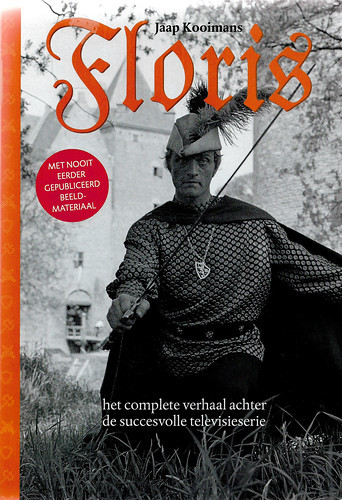
Book cover for Jaap Kooimans, 'Floris' (2018). Publisher: DATO.
This was something new and exciting
50 years ago, television on the Netherlands was still in black and white. Every Sunday, the young Jaap Kooimans and millions of other Dutch kids and their families watched a new Dutch series about a knight. I was also among them.
We had all seen and liked Ivanhoe (1958-1959) with Roger Moore from England, and Thierry la Fronde (1963-1966) with Jean-Claude Drouot from France, but this was something different: an exciting tale about the Dutch Middle Ages with castles, horses, sword fighting and eastern magic.
How thrilled we were when the opening music started. The two heroes were a young blonde and athletic knight and his friend, a mysterious Indian fakir. At the start of every episode, Rutger Hauer and Jos Bergman ;came galloping on their horses, rushing into the series. Laughing and courageously, they were looking for new adventures.
Floris (1969) was a smash hit. For instance, more than 3.5 million Dutch people watched the second episode. Imagine, there were less than 13 million inhabitants in the Netherlands at the time. And we all fell in love with the young Rutger Hauer. A star was born.
At the time, all kinds of merchandise were produced for the kids and of course these are cult objects now. For this post I uploaded vintage collectors cards of Floris (1969). The quality of these small cards, produced in 1970, is not exactly perfect, but they are quite rare these days, so I am very happy I found these.
And of course, now there is this book by Jaap Kooimans, a kind of encyclopedia on Floris. My sister gave it to me as a present for my 58th birthday.
Floris is still the favourite series for many of my generation in the Netherlands and also in Belgium. To foreigners it must be a crazy phenomenon. But if you read Jaap Kooiman's enthusiastic book you will conclude that this certainly was a very special TV series.
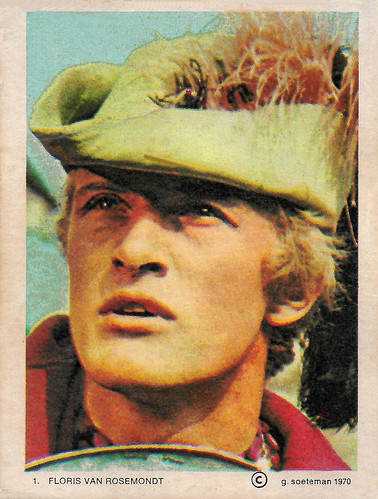
Dutch collectors card, no. 1, 1970. Photo: Gerard Soeteman. Rutger Hauer in Floris (Paul Verhoeven, 1969).
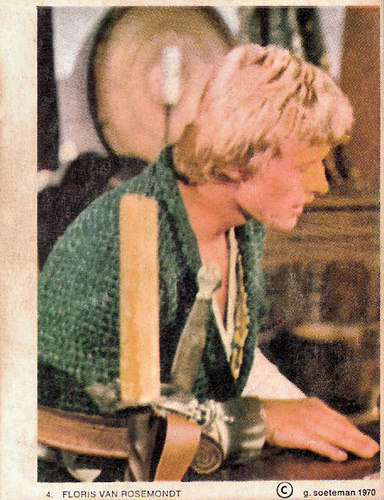
Dutch collectors card, no. 4, 1970. Photo: Gerard Soeteman. Rutger Hauer as Floris van Rosemondt in Floris (Paul Verhoeven, 1969).
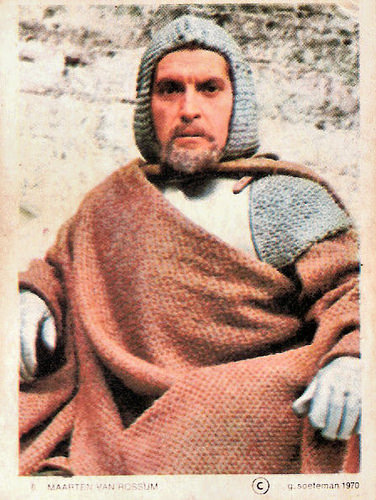
Dutch collectors card, no. 5 (?), 1970. Photo: Gerard Soeteman. Hans Culeman as Maarten van Rossum in Floris (Paul Verhoeven, 1969).

Dutch collectors card, no. 7, 1970. Photo: Gerard Soeteman. Hans Boskamp as Lange Pier in Floris (Paul Verhoeven, 1969).
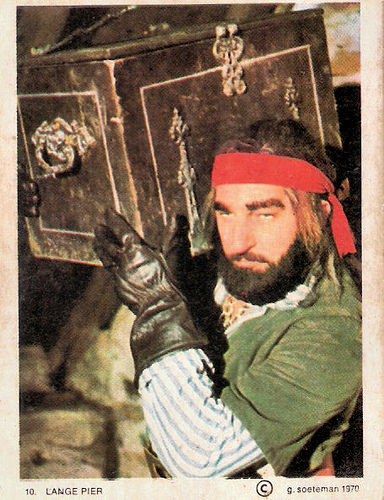
Dutch collectors card, no. 10, 1970. Photo: Gerard Soeteman. Hans Boskamp as Lange Pier in Floris (Paul Verhoeven, 1969).
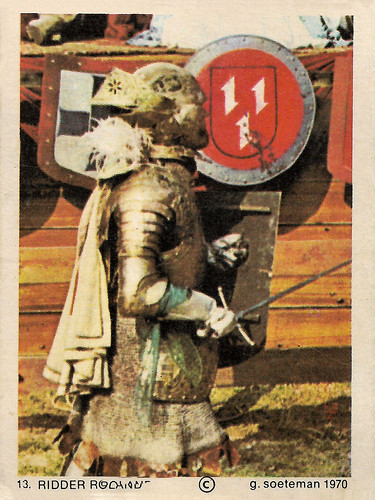
Dutch collectors card, no. 13, 1970. Photo: Gerard Soeteman. Lex Schoorel in Floris (Paul Verhoeven, 1969).

Dutch collectors card, no. 14, 1970. Photo: Gerard Soeteman. Rutger Hauer in Floris (Paul Verhoeven, 1969).
Unforgettable screen debut Rutger Hauer made his screen debut as the exiled knight Floris van Rosemondt. How young he was in 1969, but his performance in Floris is unforgettable. The handsome and athletic Hauer is the ultimate knight.
With his Indian friend Sindala (Jos Bergman), Floris tries to get his birth right papers back from Maarten van Rossem (Hans Culeman), an evil lord.
During their quest they get help from Wolter van Oldenstein (Ton Vos), a noble man who offers them a place in his castle. They also meet the imposing pirate Lange Pier (Hans Boskamp).
Apart from Sindala and Floris, all the characters are based on historical figures. Scriptwriter Gerard Soeteman did an amazingly inventive job and it is one of the reasons why so many adults love to see this children's series too.
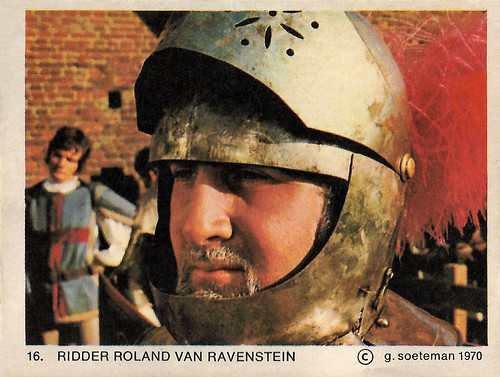
Dutch collectors card, no. 16, 1970. Photo: Gerard Soeteman. Publicity still for the TV series Floris (Paul Verhoeven, 1969).
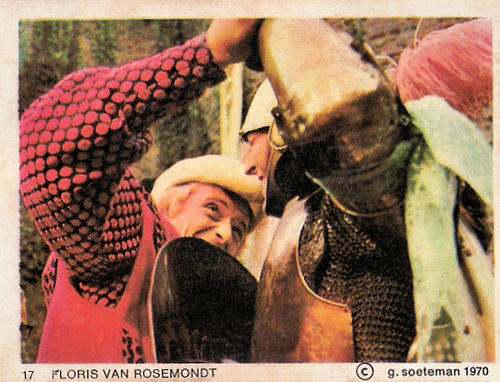
Dutch collectors card, no. 17, 1970. Photo: Gerard Soeteman. Rutger Hauer in Floris (Paul Verhoeven, 1969).
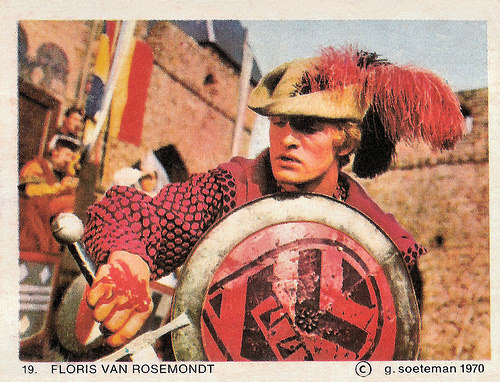
Dutch collectors card, no. 19, 1970. Photo: Gerard Soeteman. Rutger Hauer in Floris (Paul Verhoeven, 1969).
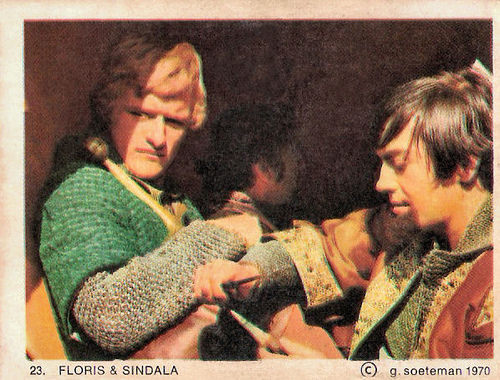
Dutch collectors card, no. 23, 1970. Photo: Gerard Soeteman. Rutger Hauer and Jos Bergman in Floris (Paul Verhoeven, 1969).
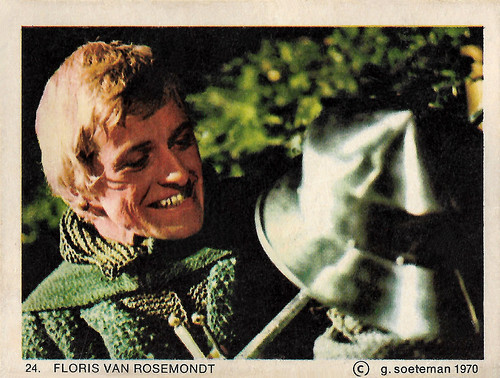
Dutch collectors card, no. 24, 1970. Photo: Gerard Soeteman. Rutger Hauer in Floris (Paul Verhoeven, 1969).
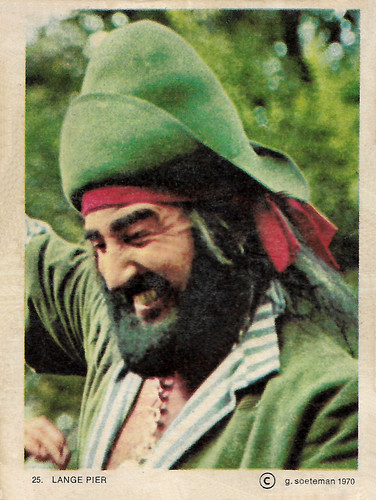
Dutch collectors card, no. 25, 1970. Photo: Gerard Soeteman. Hans Boskamp in Floris (Paul Verhoeven, 1969).
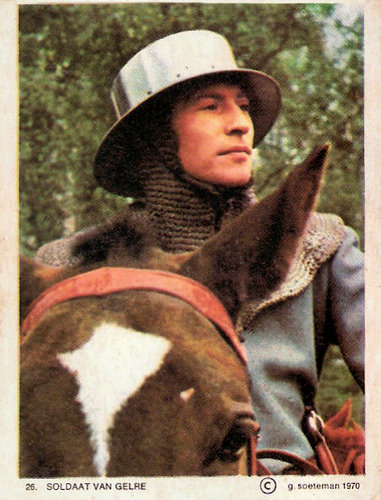
Dutch collectors card, no. 26, 1970. Photo: Gerard Soeteman. Publicity still for the TV series Floris (Paul Verhoeven, 1969). Caption: Soldaat van Gelre (Soldier Van Gelre).
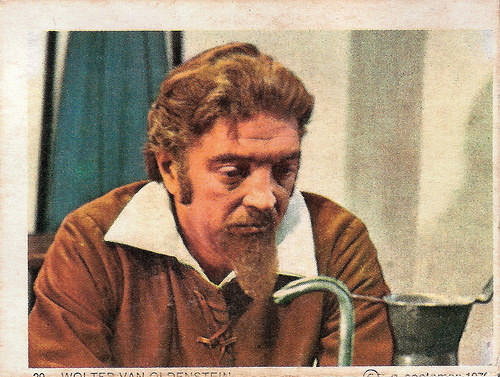
Dutch collectors card, no. 29 (?), 1970. Photo: Gerard Soeteman. Publicity still for the TV series Floris (Paul Verhoeven, 1969). Ton Vos als Wolter van Oldenstein.
In the best Robin Hood style
In 1967, the success of television series like the British Ivanhoe (1958-1959) with Roger Moore , the French Thierry La Fronde/Thierry the Sling (1963-1966) with Jean-Claude Drouot , and the Flemish Johan en de Alverman (1965) with Frank Aendenboom inspired Carel Enkelaar, manager of NTS Television to make a similar series, set in the Netherlands.
Hanne Aboe Derwort highly recommends the series at IMDb : "One of the first Middle Age series ever, the stories of the adventures of Floris in medieval Holland are also among the most funny TV-series ever.
The budget was very low, which can be seen, but the interaction between the actors is nothing less but wonderful. Floris and his trusty companion Sindala is in best Robin Hood style, but with the addition of Eastern magic to the sword fighting skills and sheer strength (and luck) of our hero. (...)
The fact that the series is in b/w actually helps, no need to mess around with anything when somebody's wounded. If you can locate the tapes, watch it."

Dutch collectors card, no. 30, 1970. Photo: Gerard Soeteman. Rutger Hauer in Floris (Paul Verhoeven, 1969).
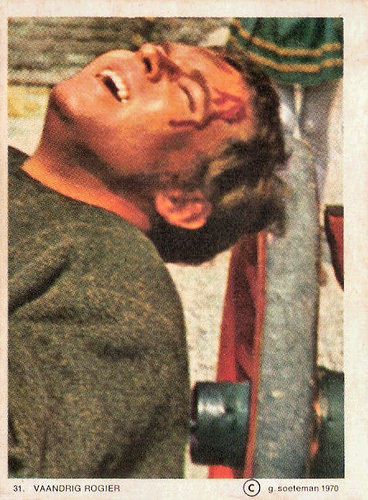
Dutch collectors card, no. 31, 1970. Photo: Gerard Soeteman. Publicity still for Floris (Paul Verhoeven, 1969). Caption: Vaandrig Rogier (Ensign-bearer Rogier). Rogier was played by Jacco van Renesse.
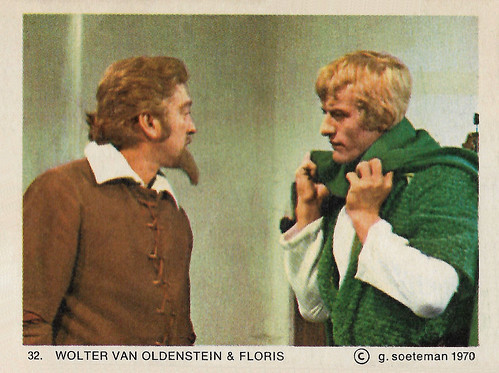
Dutch collectors card, no. 32, 1970. Photo: Gerard Soeteman. Ton Vos and Rutger Hauer in Floris (Paul Verhoeven, 1969).
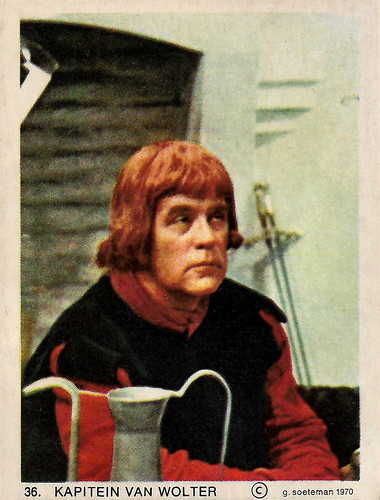
Dutch collectors card, no. 36, 1970. Photo: Gerard Soeteman. Publicity still for the TV series Floris (Paul Verhoeven, 1969).
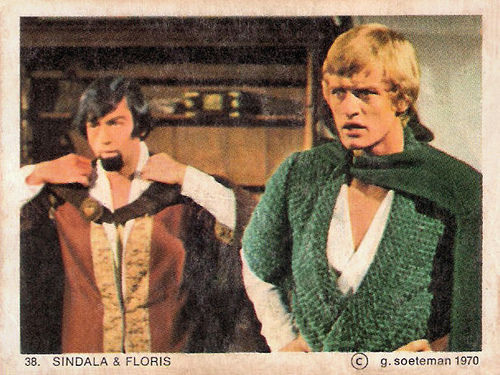
Dutch collectors card, no. 38, 1970. Photo: Gerard Soeteman. Rutger Hauer and Jos Bergman in Floris (Paul Verhoeven, 1969).
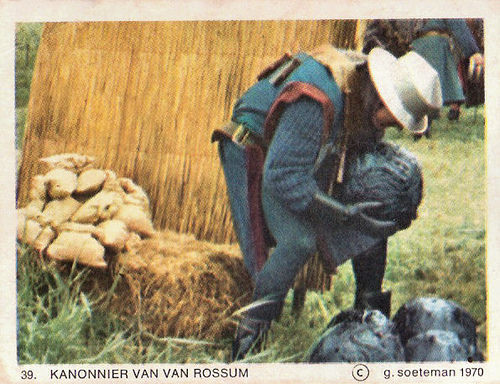
Dutch collectors card, no. 39, 1970. Photo: Gerard Soeteman. Publicity still for the TV series Floris (Paul Verhoeven, 1969). Caption: Kanonnier van Van Rossum (Gunner of Van Rossum).
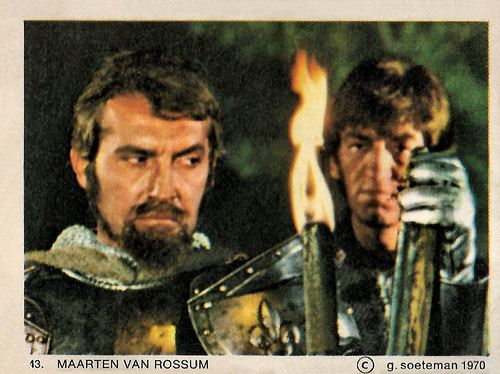
Dutch collectors card, no. 43, 1970. Photo: Gerard Soeteman. Hans Culeman and Eric Herfst in the TV series Floris (Paul Verhoeven, 1969).
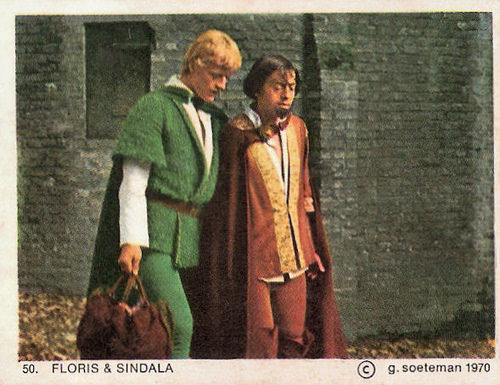
Dutch collectors card, no. 50, 1970. Photo: Gerard Soeteman. Rutger Hauer and Jos Bergman in Floris (Paul Verhoeven, 1969).
The most popular TV series in the Netherlands
In 1969, Floris was the most popular TV series in the Netherlands. The series had many reruns through the years. Floris has also been shown in East Germany (as Floris - Der Mann mit dem Schwert) and Scotland dubbed in English. In the UK, the series aired on Yorkshire Television in 1970 as The Adventures of Floris. None of the English dubbed episodes survive.
1975 saw a German remake of the series, Floris von Rosenmund (Ferry Radax, 1975), again starring Rutger Hauer , but with German actor Derval de Faria as Sindala. This version put much more emphasis on the comedic aspects of the stories. I saw some episodes and compared with the original series they 're mediocre.
The series also lead to the film Floris (Jean van de Velde, 2004) which features Michiel Huisman (known for his role in Game of Thrones) as the grandson of the original Floris. Some of the footage from the 1969 series with Hauer and Bergman is included. Rutger Hauer was originally asked to play the father of young Floris, but he declined.
In 2016 a small miracle happened. Nearly 47 years after the broadcast of the twelfth and final episode of the legendary TV series Floris, a hitherto unknown thirteenth episode premiered. The episode entitled Het gericht/Targeting was never finished for several reasons. The raw footage was owned by the writer of the series, Gerard Soeteman.
To get a full episode, artist Gerrit Stapel assembled black and white drawings between the images. Previously Stapel made the Floris comics together with Soeteman. In addition to the thirteenth episode, a documentary about the legendary series was produced, in which both Verhoeven and Soeteman provide insight into the development of Floris.
Both the 13the episode and the documentary premiered at Doornenburg castle, one of the locations of the Dutch television series. The recently deceased Rutger Hauer , then 72, was present at the belated premiere.
And now there is also this book on Floris by Jaap Kooimans. Strictly for the fans, but I am one and I loved to read it, every detail.
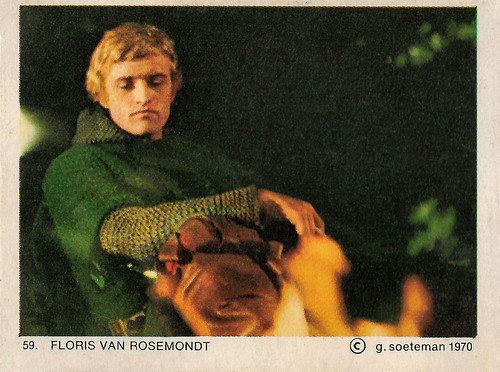
Dutch collectors card, no. 59, 1970. Photo: Gerard Soeteman. Rutger Hauer in Floris (Paul Verhoeven, 1969).
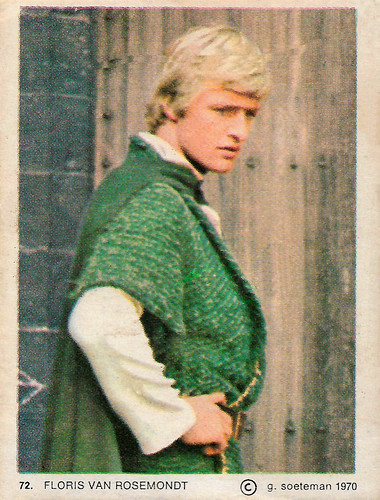
Dutch collectors card, no. 72, 1970. Photo: Gerard Soeteman. Rutger Hauer in Floris (Paul Verhoeven, 1969).
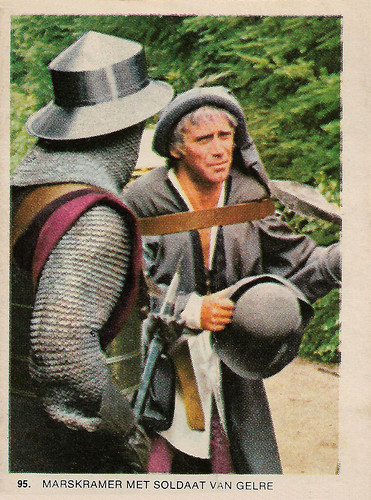
Dutch collectors card, no. 95, 1970. Photo: Gerard Soeteman. Cor Witschge in Floris (Paul Verhoeven, 1969).
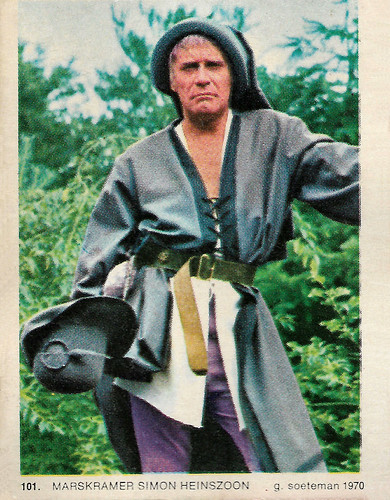
Dutch collectors card, no. 101, 1970. Photo: Gerard Soeteman. Cor Witschge in Floris (Paul Verhoeven, 1969).
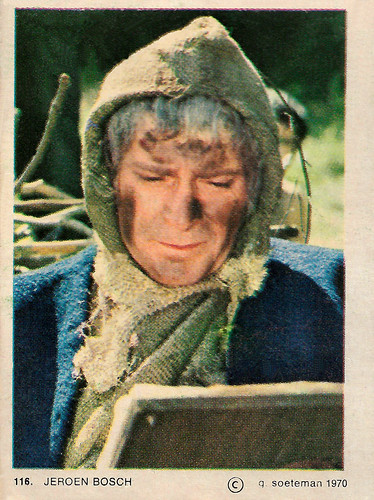
Dutch collectors card, no. 116, 1970. Photo: Gerard Soeteman. Ton Kuyl as Jeroen Bosch in Floris (Paul Verhoeven, 1969).
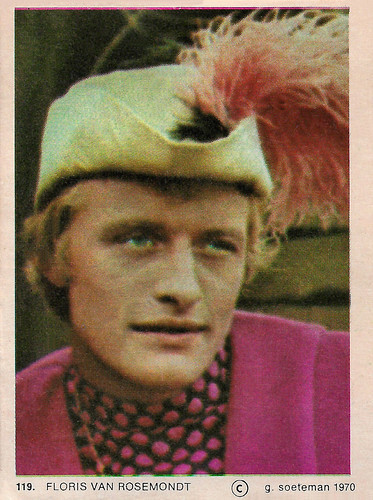
Dutch collectors card, no. 119, 1970. Photo: Gerard Soeteman. Rutger Hauer in Floris (Paul Verhoeven, 1969).
Episode Het brandende water (The burning water). Sorry, no subtitles. Source: eikcid (YouTube). Enjoy the title music by Julius Steffaro (a.k.a. Jan Stoeckart. At IMDb he is also called Jack Trombley.)
Dutch TV documentary in the series Andere tijden (Other times). Sorry, no subtitles. Source: 192TVideo (YouTube).
Source: Hanne Aboe Derwort (IMDb), Wikipedia and IMDb.

Book cover for Jaap Kooimans, 'Floris' (2018). Publisher: DATO.
This was something new and exciting
50 years ago, television on the Netherlands was still in black and white. Every Sunday, the young Jaap Kooimans and millions of other Dutch kids and their families watched a new Dutch series about a knight. I was also among them.
We had all seen and liked Ivanhoe (1958-1959) with Roger Moore from England, and Thierry la Fronde (1963-1966) with Jean-Claude Drouot from France, but this was something different: an exciting tale about the Dutch Middle Ages with castles, horses, sword fighting and eastern magic.
How thrilled we were when the opening music started. The two heroes were a young blonde and athletic knight and his friend, a mysterious Indian fakir. At the start of every episode, Rutger Hauer and Jos Bergman ;came galloping on their horses, rushing into the series. Laughing and courageously, they were looking for new adventures.
Floris (1969) was a smash hit. For instance, more than 3.5 million Dutch people watched the second episode. Imagine, there were less than 13 million inhabitants in the Netherlands at the time. And we all fell in love with the young Rutger Hauer. A star was born.
At the time, all kinds of merchandise were produced for the kids and of course these are cult objects now. For this post I uploaded vintage collectors cards of Floris (1969). The quality of these small cards, produced in 1970, is not exactly perfect, but they are quite rare these days, so I am very happy I found these.
And of course, now there is this book by Jaap Kooimans, a kind of encyclopedia on Floris. My sister gave it to me as a present for my 58th birthday.
Floris is still the favourite series for many of my generation in the Netherlands and also in Belgium. To foreigners it must be a crazy phenomenon. But if you read Jaap Kooiman's enthusiastic book you will conclude that this certainly was a very special TV series.

Dutch collectors card, no. 1, 1970. Photo: Gerard Soeteman. Rutger Hauer in Floris (Paul Verhoeven, 1969).

Dutch collectors card, no. 4, 1970. Photo: Gerard Soeteman. Rutger Hauer as Floris van Rosemondt in Floris (Paul Verhoeven, 1969).

Dutch collectors card, no. 5 (?), 1970. Photo: Gerard Soeteman. Hans Culeman as Maarten van Rossum in Floris (Paul Verhoeven, 1969).

Dutch collectors card, no. 7, 1970. Photo: Gerard Soeteman. Hans Boskamp as Lange Pier in Floris (Paul Verhoeven, 1969).

Dutch collectors card, no. 10, 1970. Photo: Gerard Soeteman. Hans Boskamp as Lange Pier in Floris (Paul Verhoeven, 1969).

Dutch collectors card, no. 13, 1970. Photo: Gerard Soeteman. Lex Schoorel in Floris (Paul Verhoeven, 1969).

Dutch collectors card, no. 14, 1970. Photo: Gerard Soeteman. Rutger Hauer in Floris (Paul Verhoeven, 1969).
Unforgettable screen debut Rutger Hauer made his screen debut as the exiled knight Floris van Rosemondt. How young he was in 1969, but his performance in Floris is unforgettable. The handsome and athletic Hauer is the ultimate knight.
With his Indian friend Sindala (Jos Bergman), Floris tries to get his birth right papers back from Maarten van Rossem (Hans Culeman), an evil lord.
During their quest they get help from Wolter van Oldenstein (Ton Vos), a noble man who offers them a place in his castle. They also meet the imposing pirate Lange Pier (Hans Boskamp).
Apart from Sindala and Floris, all the characters are based on historical figures. Scriptwriter Gerard Soeteman did an amazingly inventive job and it is one of the reasons why so many adults love to see this children's series too.

Dutch collectors card, no. 16, 1970. Photo: Gerard Soeteman. Publicity still for the TV series Floris (Paul Verhoeven, 1969).

Dutch collectors card, no. 17, 1970. Photo: Gerard Soeteman. Rutger Hauer in Floris (Paul Verhoeven, 1969).

Dutch collectors card, no. 19, 1970. Photo: Gerard Soeteman. Rutger Hauer in Floris (Paul Verhoeven, 1969).

Dutch collectors card, no. 23, 1970. Photo: Gerard Soeteman. Rutger Hauer and Jos Bergman in Floris (Paul Verhoeven, 1969).

Dutch collectors card, no. 24, 1970. Photo: Gerard Soeteman. Rutger Hauer in Floris (Paul Verhoeven, 1969).

Dutch collectors card, no. 25, 1970. Photo: Gerard Soeteman. Hans Boskamp in Floris (Paul Verhoeven, 1969).

Dutch collectors card, no. 26, 1970. Photo: Gerard Soeteman. Publicity still for the TV series Floris (Paul Verhoeven, 1969). Caption: Soldaat van Gelre (Soldier Van Gelre).

Dutch collectors card, no. 29 (?), 1970. Photo: Gerard Soeteman. Publicity still for the TV series Floris (Paul Verhoeven, 1969). Ton Vos als Wolter van Oldenstein.
In the best Robin Hood style
In 1967, the success of television series like the British Ivanhoe (1958-1959) with Roger Moore , the French Thierry La Fronde/Thierry the Sling (1963-1966) with Jean-Claude Drouot , and the Flemish Johan en de Alverman (1965) with Frank Aendenboom inspired Carel Enkelaar, manager of NTS Television to make a similar series, set in the Netherlands.
Hanne Aboe Derwort highly recommends the series at IMDb : "One of the first Middle Age series ever, the stories of the adventures of Floris in medieval Holland are also among the most funny TV-series ever.
The budget was very low, which can be seen, but the interaction between the actors is nothing less but wonderful. Floris and his trusty companion Sindala is in best Robin Hood style, but with the addition of Eastern magic to the sword fighting skills and sheer strength (and luck) of our hero. (...)
The fact that the series is in b/w actually helps, no need to mess around with anything when somebody's wounded. If you can locate the tapes, watch it."

Dutch collectors card, no. 30, 1970. Photo: Gerard Soeteman. Rutger Hauer in Floris (Paul Verhoeven, 1969).

Dutch collectors card, no. 31, 1970. Photo: Gerard Soeteman. Publicity still for Floris (Paul Verhoeven, 1969). Caption: Vaandrig Rogier (Ensign-bearer Rogier). Rogier was played by Jacco van Renesse.

Dutch collectors card, no. 32, 1970. Photo: Gerard Soeteman. Ton Vos and Rutger Hauer in Floris (Paul Verhoeven, 1969).

Dutch collectors card, no. 36, 1970. Photo: Gerard Soeteman. Publicity still for the TV series Floris (Paul Verhoeven, 1969).

Dutch collectors card, no. 38, 1970. Photo: Gerard Soeteman. Rutger Hauer and Jos Bergman in Floris (Paul Verhoeven, 1969).

Dutch collectors card, no. 39, 1970. Photo: Gerard Soeteman. Publicity still for the TV series Floris (Paul Verhoeven, 1969). Caption: Kanonnier van Van Rossum (Gunner of Van Rossum).

Dutch collectors card, no. 43, 1970. Photo: Gerard Soeteman. Hans Culeman and Eric Herfst in the TV series Floris (Paul Verhoeven, 1969).

Dutch collectors card, no. 50, 1970. Photo: Gerard Soeteman. Rutger Hauer and Jos Bergman in Floris (Paul Verhoeven, 1969).
The most popular TV series in the Netherlands
In 1969, Floris was the most popular TV series in the Netherlands. The series had many reruns through the years. Floris has also been shown in East Germany (as Floris - Der Mann mit dem Schwert) and Scotland dubbed in English. In the UK, the series aired on Yorkshire Television in 1970 as The Adventures of Floris. None of the English dubbed episodes survive.
1975 saw a German remake of the series, Floris von Rosenmund (Ferry Radax, 1975), again starring Rutger Hauer , but with German actor Derval de Faria as Sindala. This version put much more emphasis on the comedic aspects of the stories. I saw some episodes and compared with the original series they 're mediocre.
The series also lead to the film Floris (Jean van de Velde, 2004) which features Michiel Huisman (known for his role in Game of Thrones) as the grandson of the original Floris. Some of the footage from the 1969 series with Hauer and Bergman is included. Rutger Hauer was originally asked to play the father of young Floris, but he declined.
In 2016 a small miracle happened. Nearly 47 years after the broadcast of the twelfth and final episode of the legendary TV series Floris, a hitherto unknown thirteenth episode premiered. The episode entitled Het gericht/Targeting was never finished for several reasons. The raw footage was owned by the writer of the series, Gerard Soeteman.
To get a full episode, artist Gerrit Stapel assembled black and white drawings between the images. Previously Stapel made the Floris comics together with Soeteman. In addition to the thirteenth episode, a documentary about the legendary series was produced, in which both Verhoeven and Soeteman provide insight into the development of Floris.
Both the 13the episode and the documentary premiered at Doornenburg castle, one of the locations of the Dutch television series. The recently deceased Rutger Hauer , then 72, was present at the belated premiere.
And now there is also this book on Floris by Jaap Kooimans. Strictly for the fans, but I am one and I loved to read it, every detail.

Dutch collectors card, no. 59, 1970. Photo: Gerard Soeteman. Rutger Hauer in Floris (Paul Verhoeven, 1969).

Dutch collectors card, no. 72, 1970. Photo: Gerard Soeteman. Rutger Hauer in Floris (Paul Verhoeven, 1969).

Dutch collectors card, no. 95, 1970. Photo: Gerard Soeteman. Cor Witschge in Floris (Paul Verhoeven, 1969).

Dutch collectors card, no. 101, 1970. Photo: Gerard Soeteman. Cor Witschge in Floris (Paul Verhoeven, 1969).

Dutch collectors card, no. 116, 1970. Photo: Gerard Soeteman. Ton Kuyl as Jeroen Bosch in Floris (Paul Verhoeven, 1969).

Dutch collectors card, no. 119, 1970. Photo: Gerard Soeteman. Rutger Hauer in Floris (Paul Verhoeven, 1969).
Episode Het brandende water (The burning water). Sorry, no subtitles. Source: eikcid (YouTube). Enjoy the title music by Julius Steffaro (a.k.a. Jan Stoeckart. At IMDb he is also called Jack Trombley.)
Dutch TV documentary in the series Andere tijden (Other times). Sorry, no subtitles. Source: 192TVideo (YouTube).
Source: Hanne Aboe Derwort (IMDb), Wikipedia and IMDb.
Published on August 07, 2019 22:00
Paul van Yperen's Blog
- Paul van Yperen's profile
- 13 followers
Paul van Yperen isn't a Goodreads Author
(yet),
but they
do have a blog,
so here are some recent posts imported from
their feed.



